25 Best Tools for Motion Design in 2025 (Backed by Real Designers and Reddit)


Not sure which motion design tools are worth your time in 2025? This guide breaks down the process by use case, from UI to 3D, featuring real-world picks from working designers and insights from Reddit. You'll learn which tools to start with, how pros stack them, and what’s useful (versus just trendy), so you can stop guessing and build a workflow that fits.
If you’ve ever turned to Reddit to figure out which motion design tool to learn, you’ve probably seen the chaos: After Effects is the industry standard, but also ancient. Blender? Insanely powerful and equally overwhelming. Rive? Cool, lightweight, but definitely niche.
As a motion design studio and on-demand creative partner, we at TodayMade get how confusing it can be, especially if you're just starting out or trying to level up your toolkit. That’s why we decided to cut through the noise.
We asked our own motion designers, sifted through Reddit gems, and built a practical guide to the tools that make sense, organized by use case, skill level, and budget. We’ve created a designer-tested roadmap for selecting what works, based on where you are and where you want to go.
Let’s zoom out and look at the big picture.
Ask any motion designer what tool they use, and you’ll get a question back: “For what exactly?”
That’s because motion design in 2025 is about building a stack, a combination of tools that fit your workflow, your projects, and your budget.
Let’s start with the obvious: After Effects (AE) is still the industry default. Like it or not, AE is the tool most studios and clients expect you to know. It’s bloated, powerful, and its UI hasn’t changed since the invention of fire. But for compositing, 2D animation, and plugin-based wizardry, it still reigns.
But the landscape is shifting. Tools like Cavalry, Rive, and Spline are gaining traction, especially among designers focused on real-time animation, interactive motion, or clean UI workflows.
Here’s how one Redditor on r/MotionDesign summed it up, “Currently on the list: Blender, After Effects, Premiere Pro, Davinci Resolve, Cinema 4D, Nuke, Natron, Cavalry, Houdini, UE 5.
I assume that the most popular choice is After Effects + Premiere Pro + C4D, but I'm not sure if it is the most efficient set nowadays...”
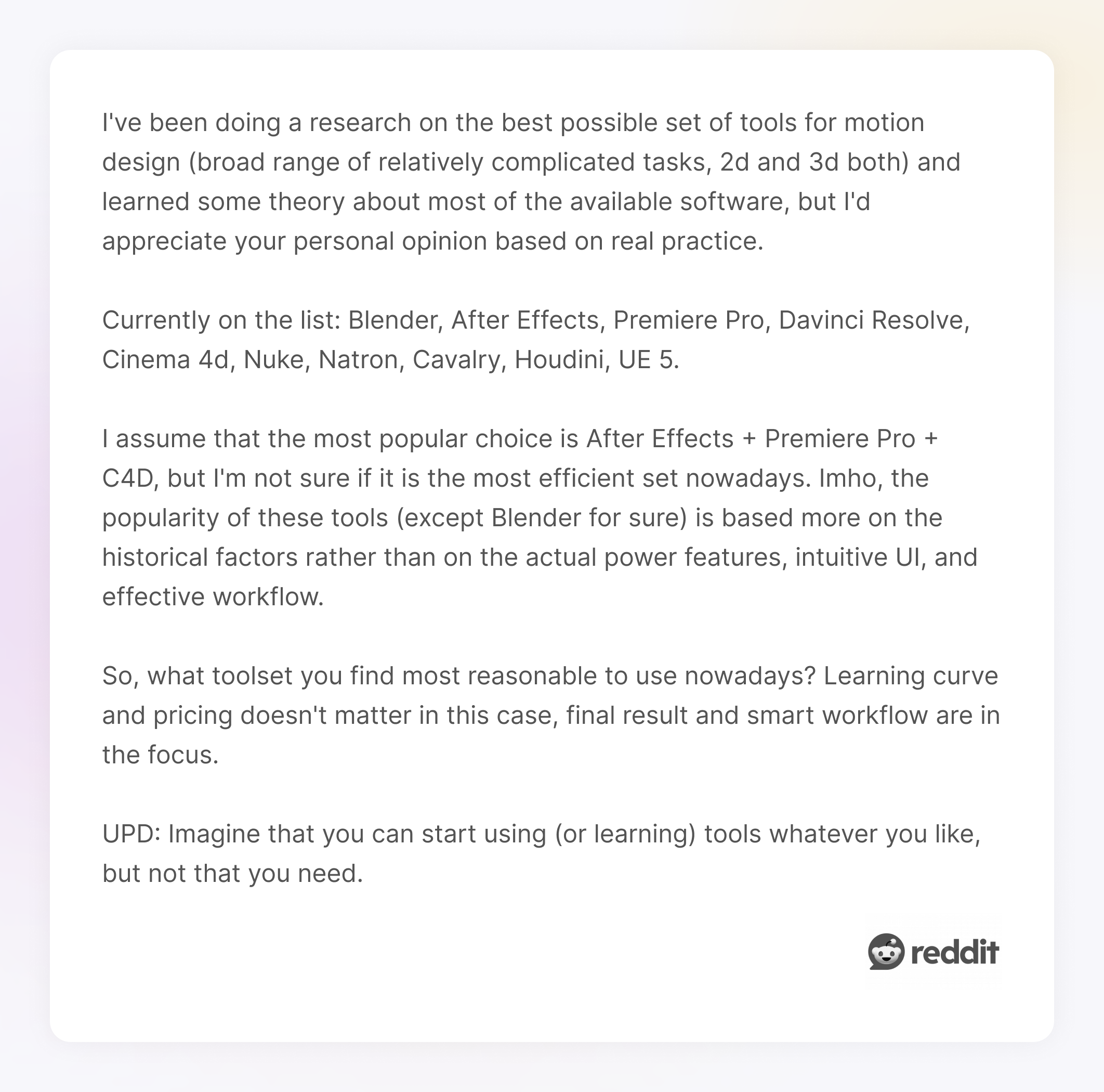
Also, speed matters. Designers are under pressure to deliver faster. A/B test more. Animate for real devices. That’s why stacks are becoming the norm: one tool to rough it out, one to clean it up, one to export it just right.
As our motion designer Yevhen Borishevskii at TodayMade puts it, “If I need to ship fast, I’ll go straight to Rive. But if I want total control, AE is still my finisher.”
Don’t waste time searching for “the best” motion design tool. Focus on finding the right tool for the job, and be ready to mix.
Or, as another Redditor put it, “Cavalry offers quite a bit of capability that AE lacks. My suggestion is to stop focusing on tools and start focusing on the craft. Ae is just a hammer, focus on what you're hammering.”
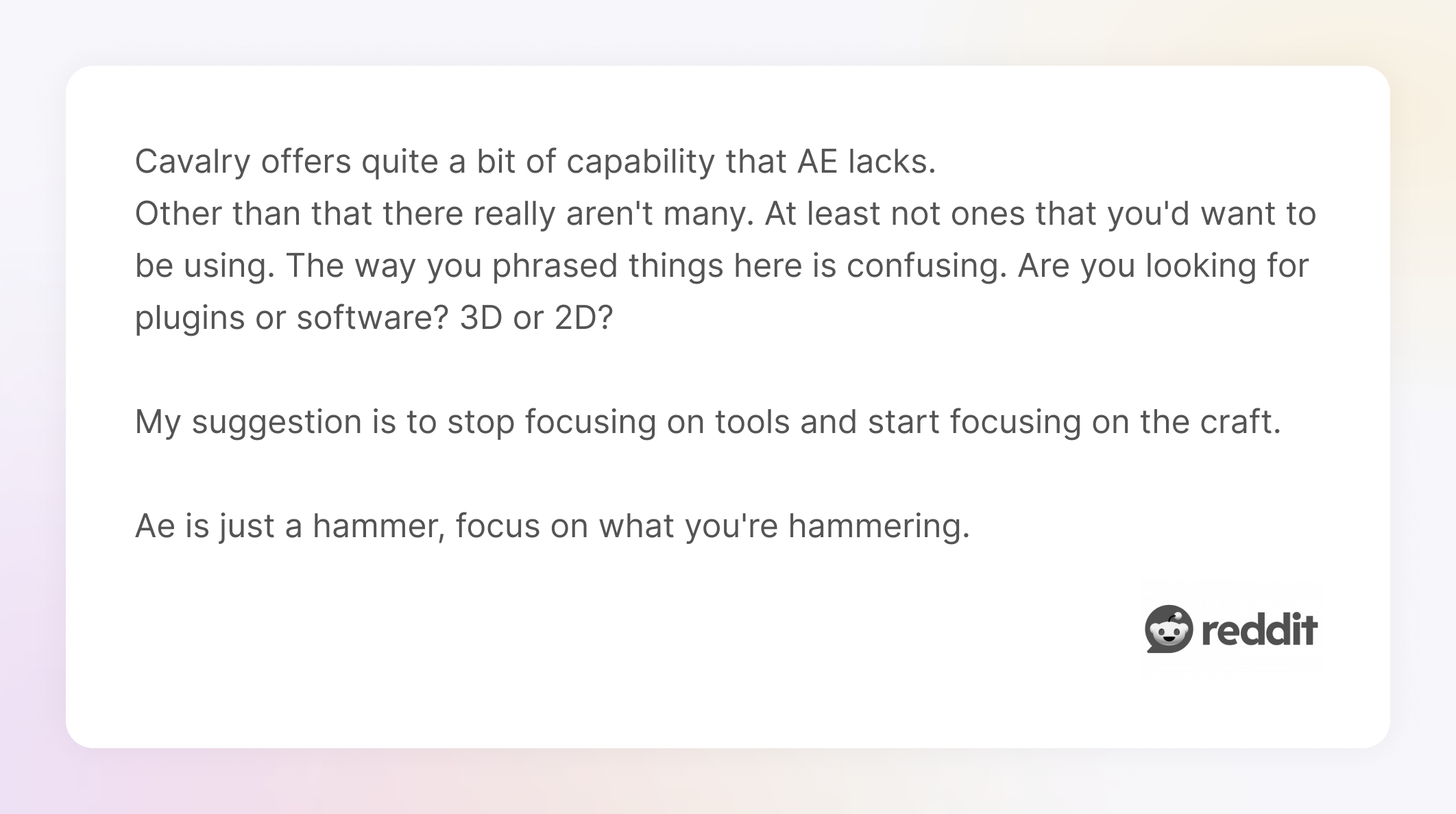
Next, let’s go deeper into the actual tools organized by their intended use. To make sense of all this, here’s a simplified breakdown of today’s motion tools:
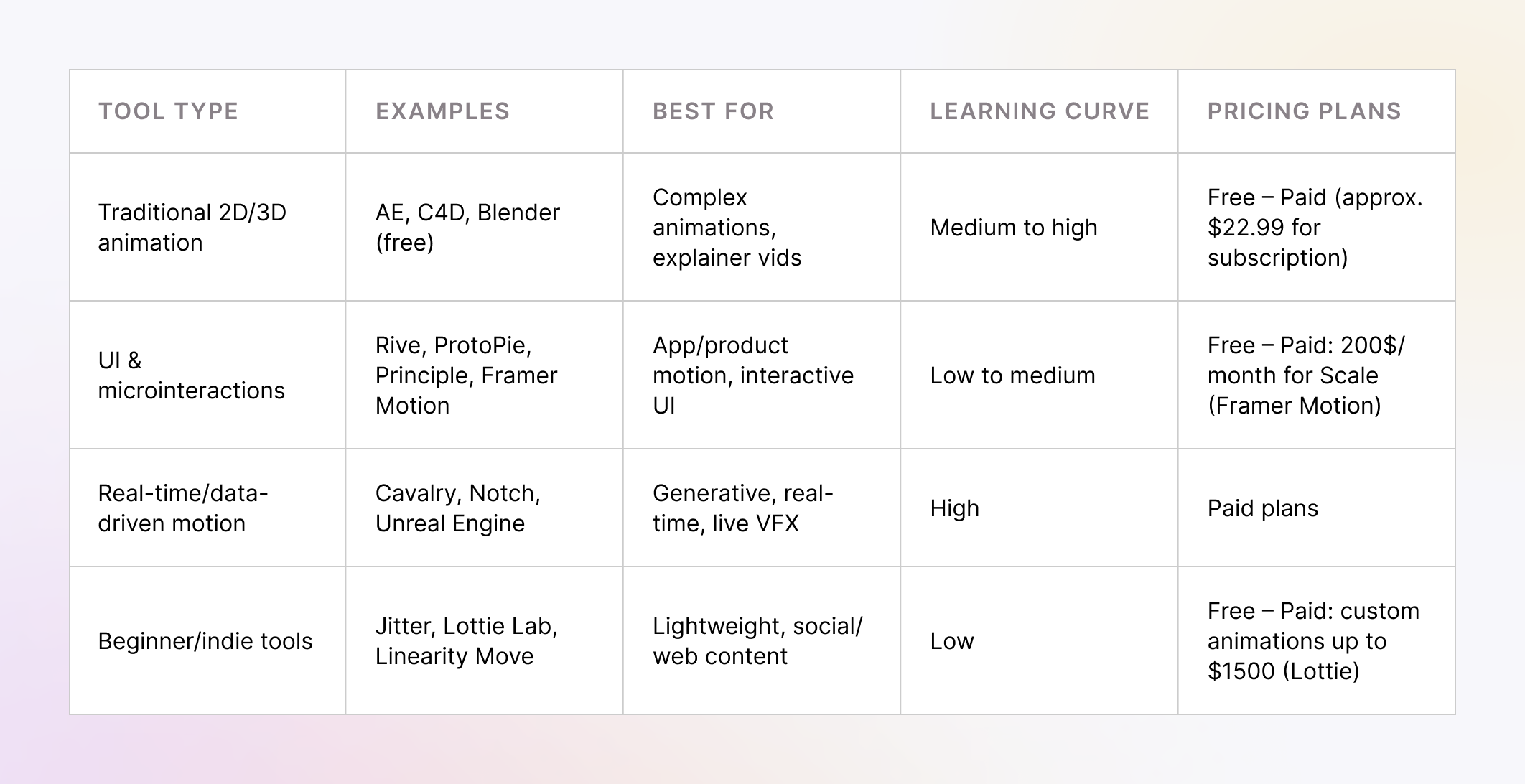
You don’t need a hundred tools. You just need the right few and to know what they’re good for.
We’ve broken down the best tools for motion design by purpose: from must-have core apps to tools for UI, real-time motion, and beginner-friendly animation. Each one comes with quick pros and cons, as well as thoughts from real designers (not just marketing pages).
These are the heavy-hitters. If you do commercial motion design, you’ve either used this best motion graphics software or will use it.
1. After Effects
After Effects is still the gold standard for motion graphics software, whether you're animating a logo, compositing footage, or adding visual effects, AE remains a go-to for studios and freelancers alike. It’s powerful, flexible, and yes, a bit old-school.
Our motion designer Evhen recommends pairing it with Magic Bullet Looks for fast, high-quality color correction: “Magic Bullet Looks is one of the best plugins for achieving that polished, high-end look fast. It offers ready-made styles, from warm cinematic to cool, dramatic, and lets you adjust everything visually: vignettes, grain, blur, and color balance, without the need for heavy grading. It’s perfect when you need to create ads, music videos, or social content quickly.”
Best for: 2D animation, compositing, motion graphics.
Pros: Industry standard, rich plugin ecosystem, highly versatile.
Cons: Outdated UI, steep learning curve, resource-heavy.
It may not be the sleekest or most efficient tool out there, but knowing AE still opens the most doors.
2. Cinema 4D
Cinema 4D is a favorite for motion designers diving into 3D. It’s known for its smooth learning curve (compared to other 3D tools), powerful Mograph capabilities, and tight integration with After Effects.
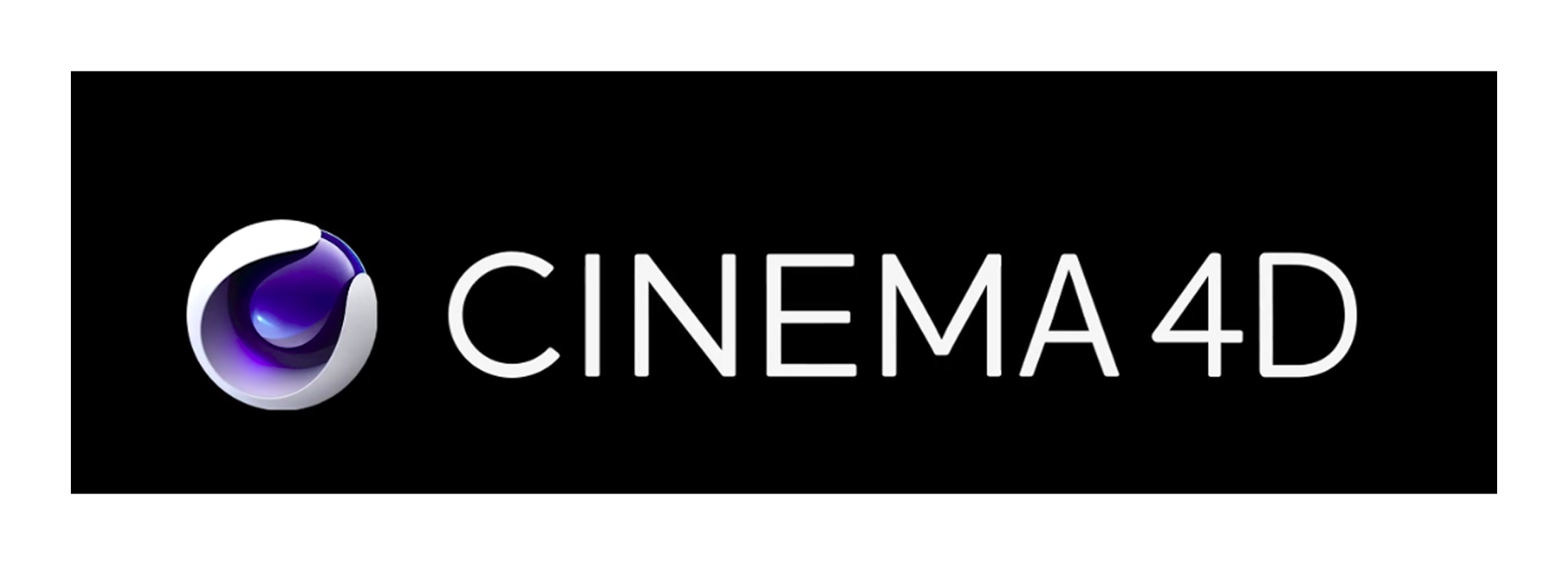
It’s often bundled with AE through Maxon One, so many designers use both together: AE for compositing, C4D for 3D animation and rendering.
Best for: 3D animation, motion graphics, high-quality renders.
Pros: Powerful mograph tools, stable, and integrates seamlessly with AE.
Cons: Pricey, and can feel overwhelming at first.
If you're coming from AE, C4D is a natural next step into the 3D world, without the chaos of steeper tools like Blender or Houdini.
3. Blender
Blender is the go-to 3D tool for designers who want power without the price tag. It’s open source, endlessly flexible, and supported by a massive community of artists, developers, and tinkerers.
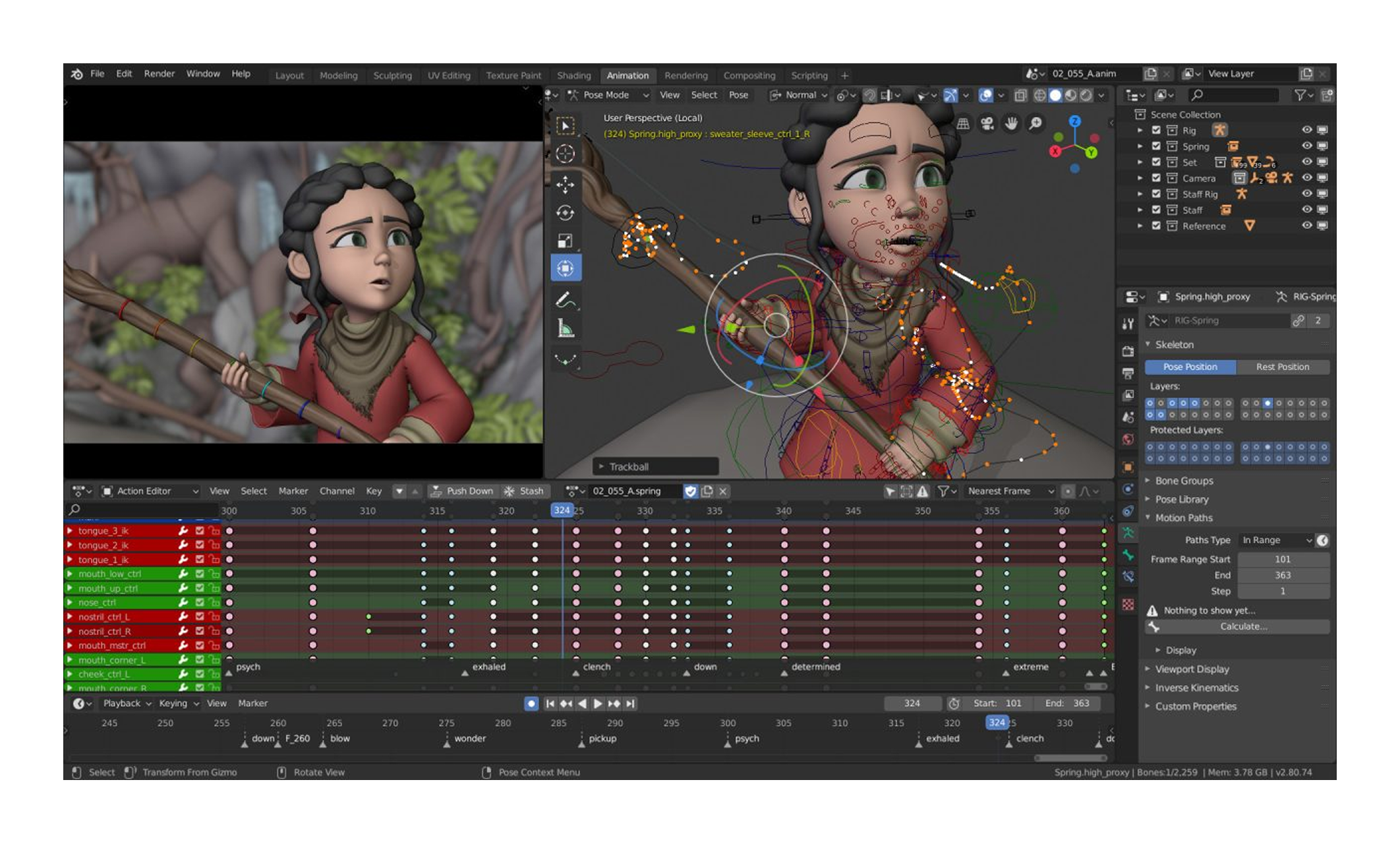
While it’s not built specifically for motion design, it can handle everything from modeling and animation to simulation and rendering, once you get past the learning curve.
Best for: Free 3D modeling, engaging animation, and rendering.
Pros: Open source, incredibly powerful, huge online community.
Cons: Dense UI, not tailored for motion design workflows.
If you’re willing to invest the time, Blender can replace or even outperform modeling tools that cost thousands, no subscription required.
4. Figma + Lottie + AE workflow
This trio is a solid workflow for UI motion in apps, websites, and prototypes. Design in Figma, animate in After Effects, and export lightweight, code-friendly, stunning animations with Lottie.
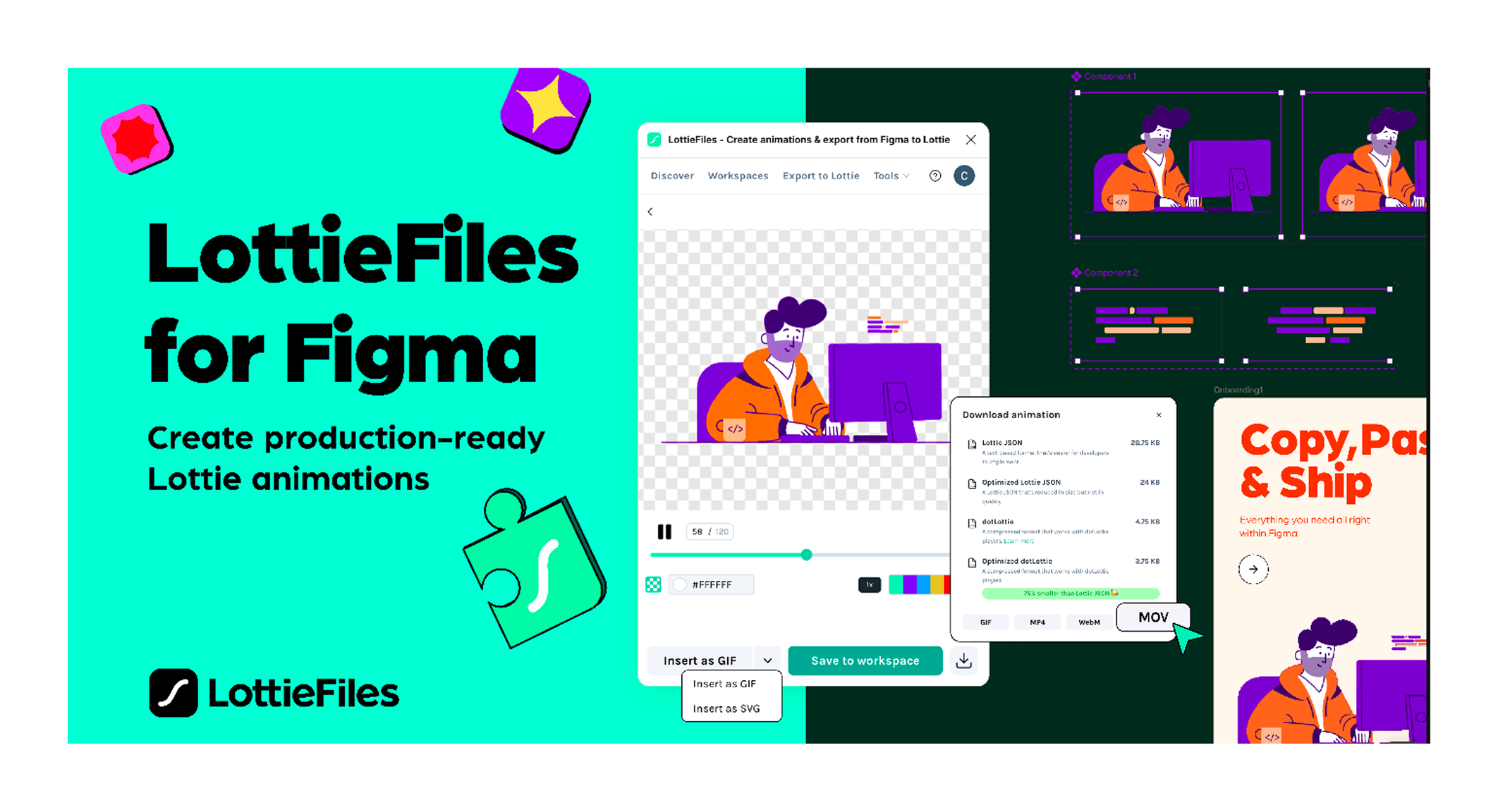
It’s a favorite for teams that need clean motion and seamless developer handoff.
Best for: UI motion for apps and the web.
Pros: Great for dev handoff, lightweight animations, efficient workflow.
Cons: Requires juggling multiple different tools.
If you're working on interactive products, this stack bridges the gap between design and development without bloating your file sizes.
Need to show a hover state, screen transition, or fun micro-moment? This motion graphic design software shines:
5. Rive
Rive is built for real-time, interactive motion, perfect for in-app animations and interactive UI. It lets designers create, animate, and ship interactive motion without writing code, and it runs smoothly across platforms.
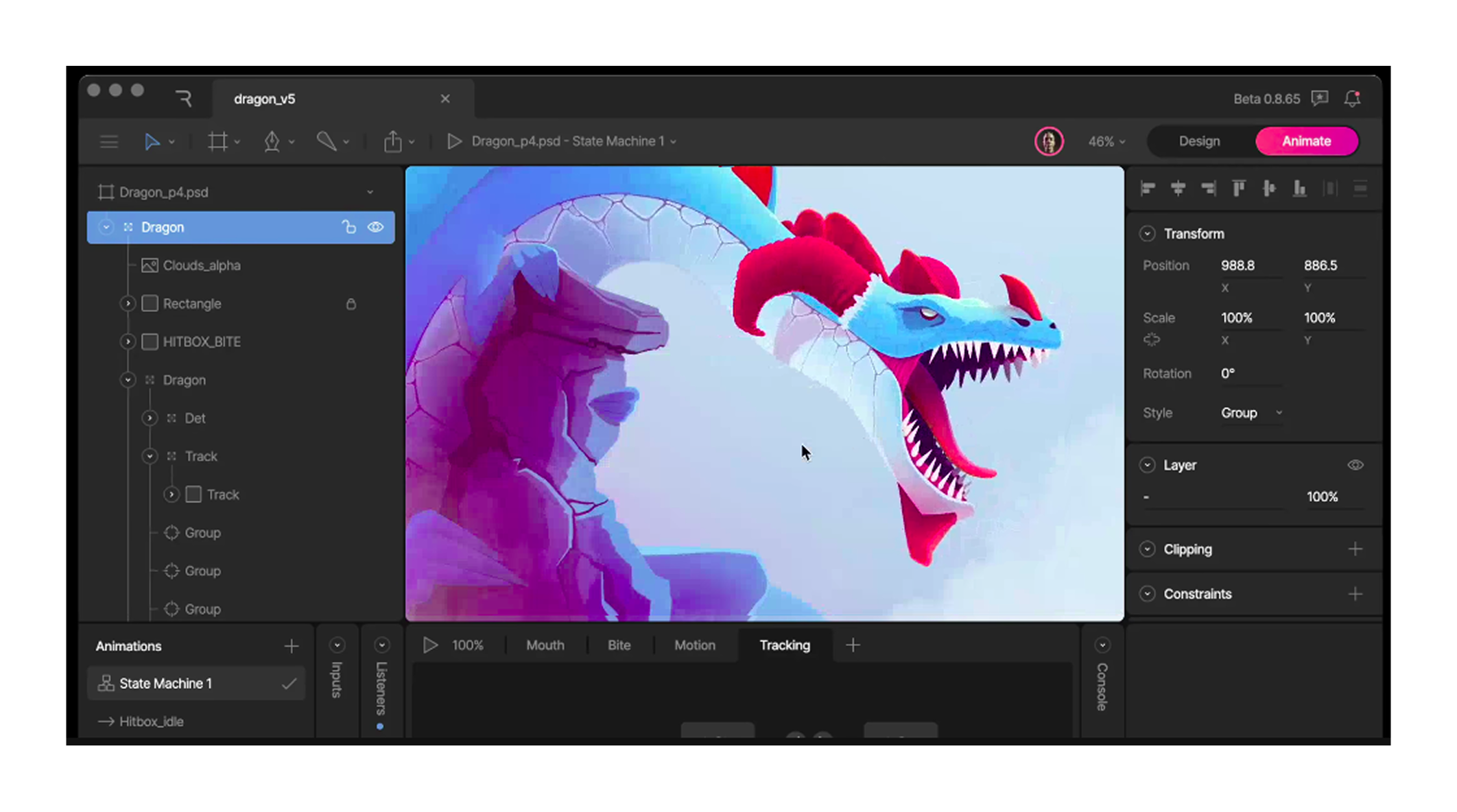
The interface is clean and intuitive, making it ideal for fast iteration. It’s especially popular for teams building animated components in apps, games, or smart devices.
Best for: Interactive UI, in-app animations.
Pros: Lightweight, real-time playback, intuitive interface.
Cons: Still evolving, not suited for complex 3D or cinematic scenes.
If you need motion that reacts to user input, Rive is one of the most efficient tools out there, and it’s only getting better.
6. ProtoPie
ProtoPie is a powerful tool for building realistic motion prototypes with interaction logic. It’s ideal for UI/UX teams who want to test how an app or interface feels beyond static mockups.
With features like variables, conditions, and sensors, you can simulate real app behavior without writing code.
Best for: UI/UX motion prototypes.
Pros: Excellent for app logic, realistic interactions, no coding required.
Cons: Geared more toward testing than final production.
If you're designing microinteractions or flows that need real input logic, ProtoPie helps you prototype as if you were building the real thing, without the need for development time.
7. Motion
Motion is a powerful animation library for React, perfect for adding smooth, performant motion to modern websites. It’s lightweight, intuitive for developers, and production-ready out of the box.

It’s a favorite among frontend teams, but since it’s code-first, designers without React experience may struggle.
Best for: React-based motion on websites.
Pros: Developer-friendly, high performance, smooth animations.
Cons: Requires React knowledge, not ideal for non-coders.
If your team lives in code, Framer Motion is one of the best ways to bring UI to life without sacrificing performance or control.
8. Spline
Spline makes it easy to design and embed interactive 3D elements directly into websites. With its intuitive, browser-based interface, it’s great for adding visual flair to landing pages and product sites, without requiring extensive 3D knowledge.
It’s not built for deep 3D workflows, but it shines when you want something lightweight, fast, and fun.
Best for: 3D elements in web interfaces.
Pros: Easy to embed, playful UI, web-friendly.
Cons: Limited for complex scenes or cinematic renders.
Spline is perfect for playful 3D touches that elevate your UI without slowing things down.
9. Principle
Principle is a longtime favorite for designing smooth app transitions and UI flows. Its clean timeline and intuitive interface make it easy to prototype animations without writing code, ideal for mobile and product designers.
While it lacks dev handoff features and is Mac-only, it’s still a go-to for quick, high-fidelity interaction design.
Best for: App transitions and flows.
Pros: Intuitive interface, timeline-based animation, fast prototyping.
Cons: Mac-only, no code export or advanced logic.
If you want to show how screens connect and feel, Principle is still one of the fastest ways to do it.
These tools target motion designers who work on generative, live, or interactive animation.
10. Cavalry
Cavalry is built for modern motion design, especially when you need speed, modularity, and data-driven animation. Think of it as After Effects reimagined with real-time feedback, procedural workflows, and powerful expressions.
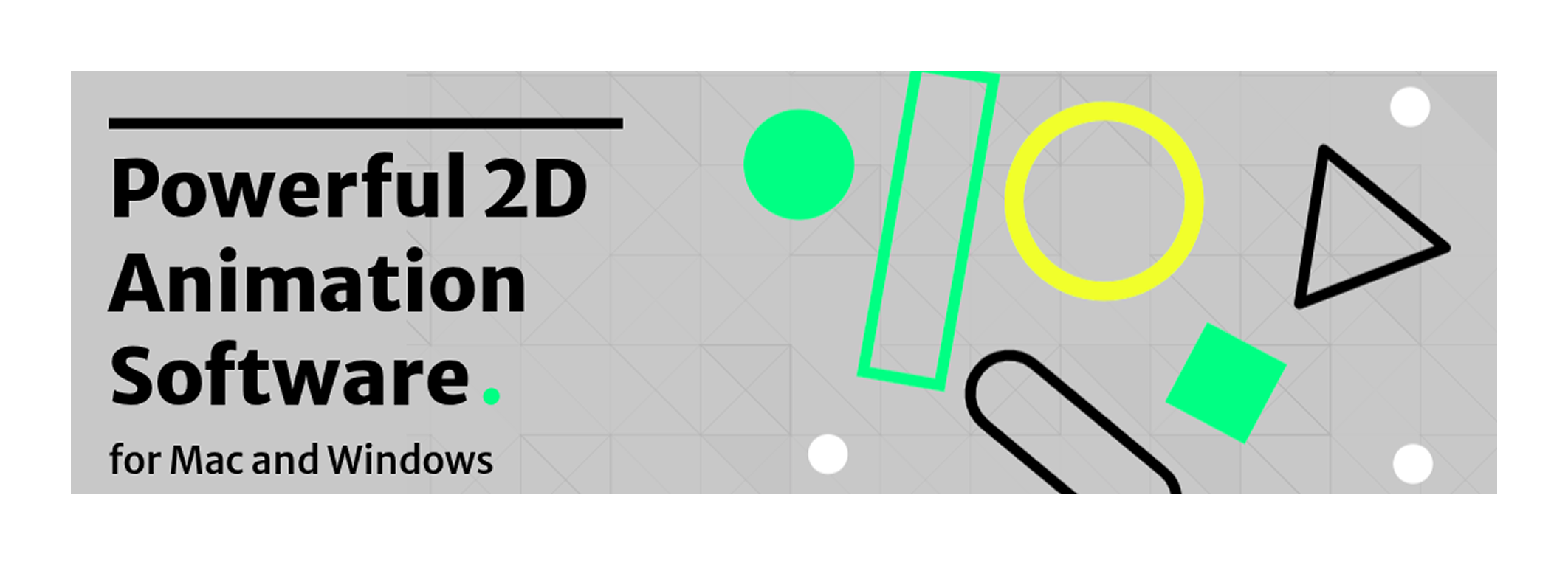
It’s incredibly capable, but still relatively niche and better suited for intermediate to advanced users.
Best for: Data-driven animation, real-time motion workflows.
Pros: Fast, modular, great for complex logic and expressions.
Cons: Still niche, steeper learning curve for beginners.
If you’re hitting AE’s performance ceiling, Cavalry might be your next favorite tool.
11. Unreal Engine
Unreal Engine is the heavyweight of real-time 3D. Initially built for gaming, it now powers everything from virtual production to product launches with cinematic-quality visuals and real-time rendering that’s hard to beat.
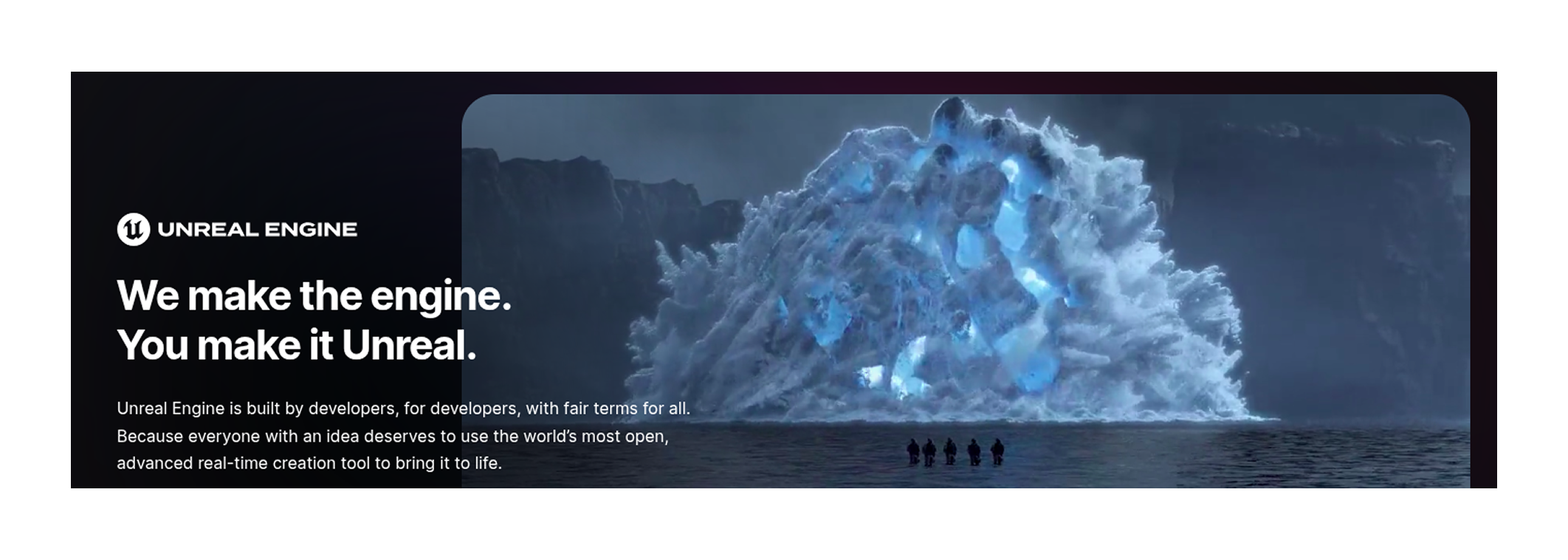
It’s powerful, but the setup is heavy and the learning curve steep. Not ideal for quick motion tasks, but unmatched for high-end, immersive experiences.
Best for: Cinematic real-time visuals, virtual production, immersive 3D.
Pros: Industry-leading rendering, real-time power, highly customizable.
Cons: Massive install size, complex workflows, not motion design-specific.
If you need blockbuster-level 3D and have the time to learn it, Unreal delivers.
12. Notch
Notch is built for real-time performance visuals, from VJing to immersive installations. It’s a staple in the world of concerts, events, and large-scale visuals where speed and flexibility matter most.
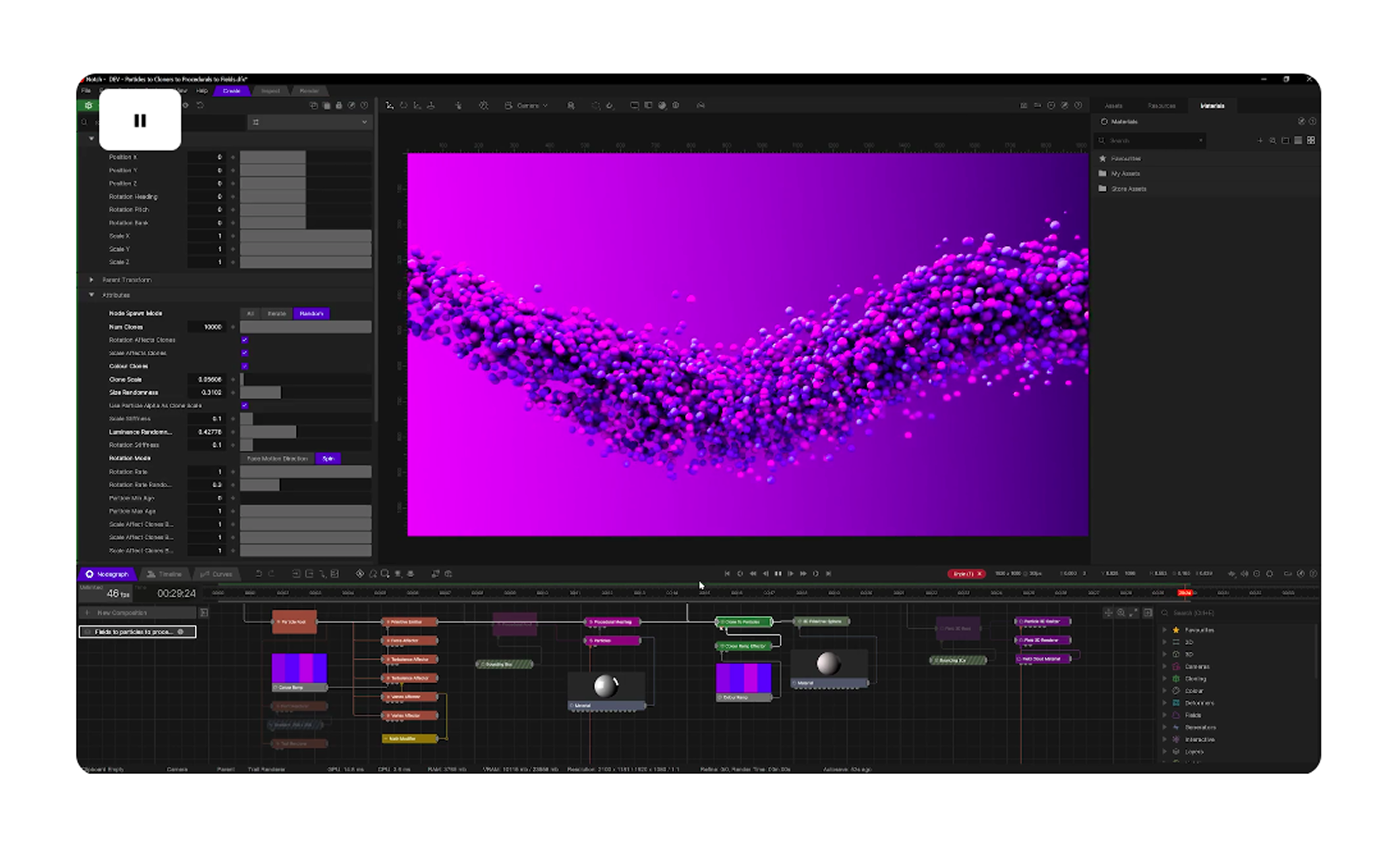
Designed for live outputs, Notch excels at creating effects that respond in real time. But it’s resource-hungry and comes with a premium price tag.
Best for: Live visuals, VJing, real-time FX.
Pros: Built for performance, real-time rendering, and powerful visuals.
Cons: Expensive, hardware-intensive, niche use case.
If your work hits the stage or the screen live, Notch is one of the best tools for show-ready motion.
This easy motion graphics software is fast, simple, and lightweight. Perfect for social content, MVPs, or just learning the ropes.
13. Jitter
Jitter is a lightweight, browser-based motion graphics tool for creating quick motion graphics and UI micro-interactions. It’s perfect for social content, prototypes, and fast turnarounds, no motion experience required.
The feature set is basic, but that’s also what makes it approachable.
Best for: Social motion content, micro-animations.
Pros: Browser-based, simple UI, fast to learn.
Cons: Limited features, not for complex projects.
If you need to animate something today, without touching After Effects, Jitter is a great place to start.
14. Lottie Lab
Lottie Lab is a motion design tool made specifically for UI animation using the Lottie format. It’s designed for Figma-based teams who want to bring their interfaces to life without leaving the design ecosystem.
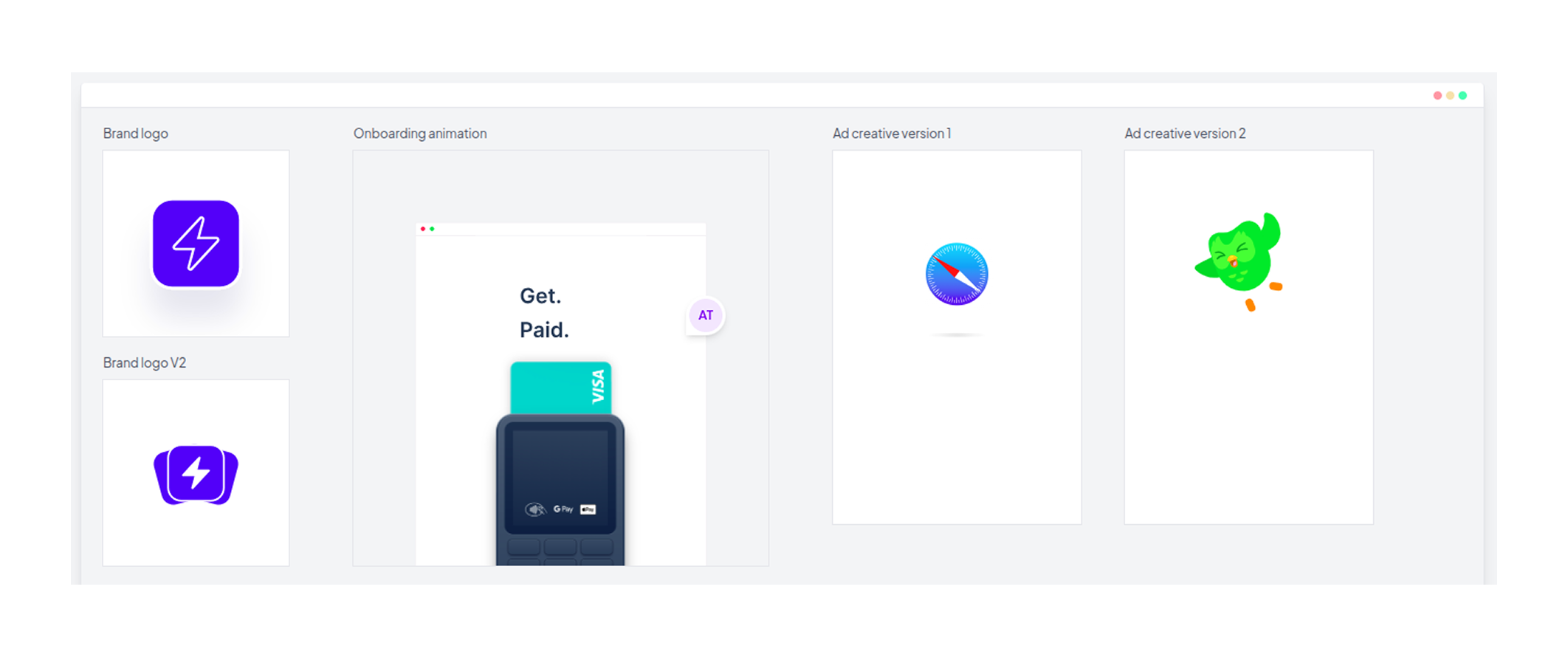
It’s still early in its development, but it's already useful for lightweight motion and smooth handoff to devs.
Best for: UI motion for apps.
Pros: Lottie-native, Figma integration, easy for designers.
Cons: Still new, limited export/control options.
If your team already lives in Figma, Lottie Lab is a natural extension for motion, without the need for AE or code.
15. Haiku Animator
Haiku Animator was built to bridge the gap between design and code for interactive web animations. It offered a UI-friendly way to create motion and export clean code for developers, ideal for lightweight interactive experiences.
Although the tool has been officially abandoned, it still works and can be surprisingly handy for simple web motion projects.
Best for: Interactive web motion.
Pros: Code export, designer-friendly UI, lightweight.
Cons: No longer maintained, limited long-term support.
If you need quick animation-to-code workflows and can live without updates, Haiku Animator still holds its own.
16. SpiritApp
SpiritApp is a simple yet powerful tool for animating SVGs using visual keyframes. It’s great for designers who want complete control over vector animations without diving into code, and it previews everything live in the browser.
It’s limited to SVGs, but that’s also its strength if vector motion is your focus.
Best for: SVG animations.
Pros: Visual keyframing, browser-based preview, lightweight.
Cons: SVG-only, not suited for complex or non-vector motion.
If you're animating logos, icons, or UI elements, SpiritApp offers a focused, frictionless workflow.
17. Linearity Move
Linearity Move is a new vector animation tool aiming to simplify motion design without losing depth. Built by the team behind Vectornator, it offers After Effects-style timelines in a cleaner, more approachable UI, all tailored for designers.
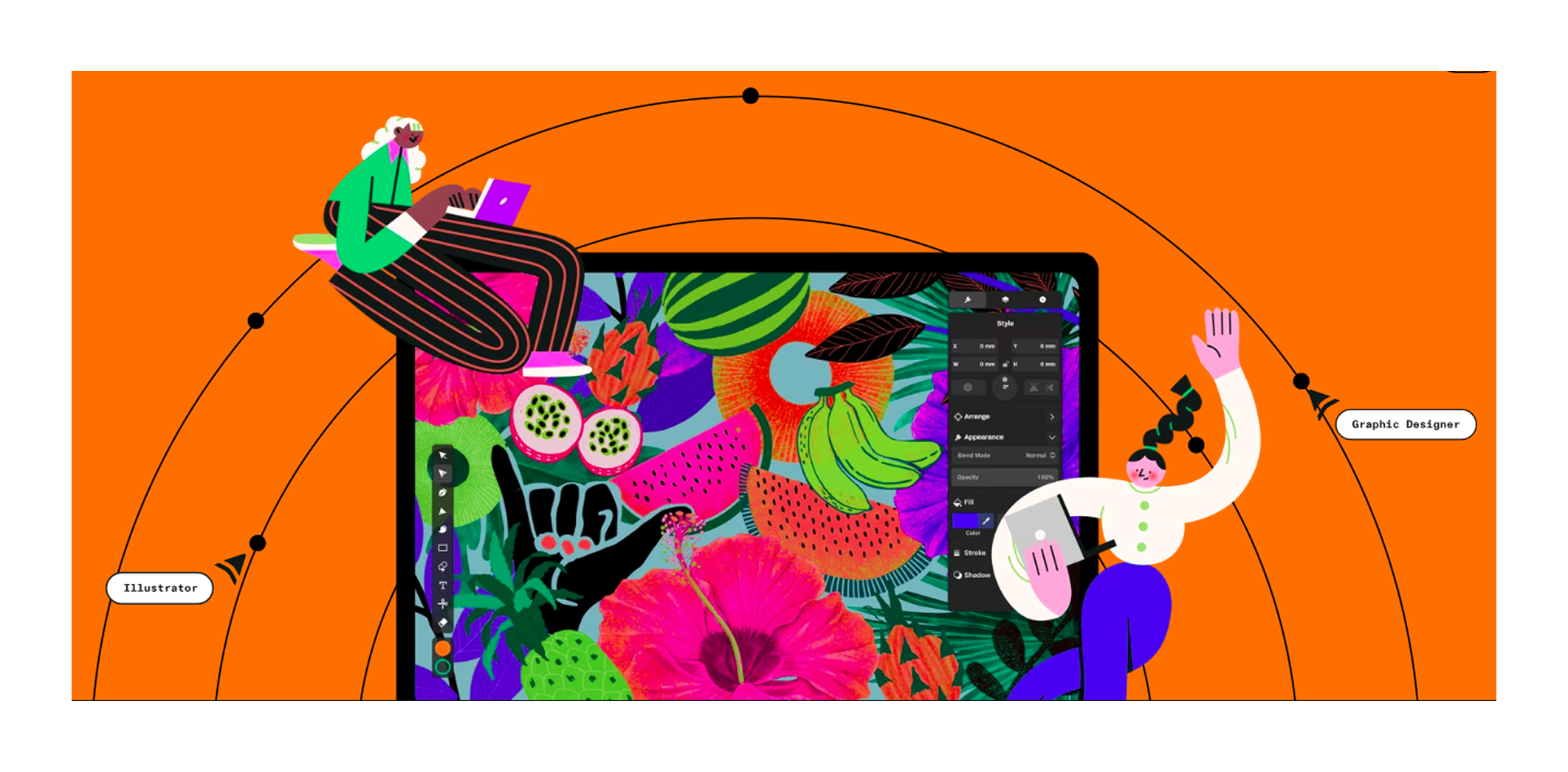
It’s still in beta, but already shows promise for anyone working with vector assets. Built by the makers of Vectornator, promising start.
Best for: Vector animation.
Pros: AE-style timeline, simplified interface, design-friendly.
Cons: Still in beta, evolving feature set.
If you're looking for AE-style control without AE-level complexity, Linearity Move is one to watch.
18. Aninix
Aninix is a browser-based tool designed for quick, exploratory motion design. Its clean interface makes it easy to experiment with timing, easing, and animation ideas, perfect for prototyping or visualizing concepts before jumping into heavier tools.
It’s not built for production work yet, but it's excellent for fast iterations. Not mainstream yet, but fun to play with.
Best for: Exploratory motion ideas.
Pros: Clean UI, modern feel, no install needed.
Cons: Limited flexibility, not production-ready.
If you just want to test ideas quickly, Aninix is a low-friction way to get moving.
Now let’s go back to the studio: what does our motion designer recommend?
To balance out the chaos, we asked Yevhen Borishevskii, motion designer at TodayMade, to share his perspective. He’s worked on everything, from slick UI animations to full-on explainer videos, and has battle-tested just about every motion tool that matters.
Here’s his shortlist of go-to plugins and why they make a difference:
There’s no single “best” setup, but you’ll always get better results with tools that fit your goals, workflow, and team.
Next, we’ll show you how these tools fit together in real workflows for different types of motion designers.
Tools don’t live in isolation. Designers seldom rely on just one; they build stacks. A tool for concepting. A tool for animating. Another one for final polish or handoff.
Here are a few typical “band setups” we’ve seen in the wild, from Reddit, TodayMade clients, and our studio.
Tool stack: After Effects + Illustrator + Mocha
This designer works primarily in After Effects and Illustrator. Most visuals start in Illustrator, then are rigged, tracked, and animated in AE.
As one Redditor explains, “As an old motion designer, I can tell you that for me I learned Illustrator long before After Effects was available and as a result, I can do things with After Effects using Illustrator techniques that most rarely bother to learn…”
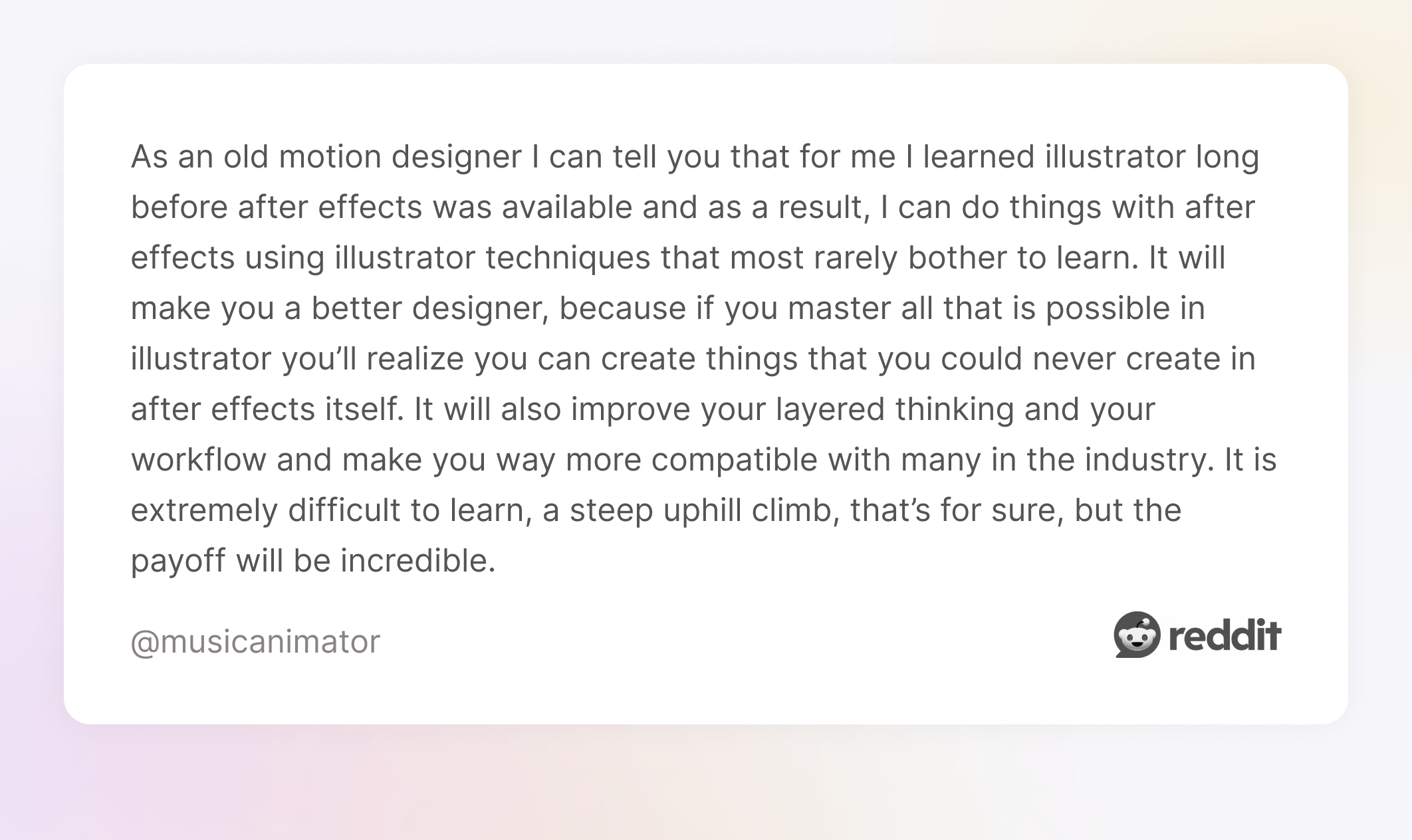
Another adds that Mocha is indispensable for complex scenes, “MochaPro is the best planar tracker”.
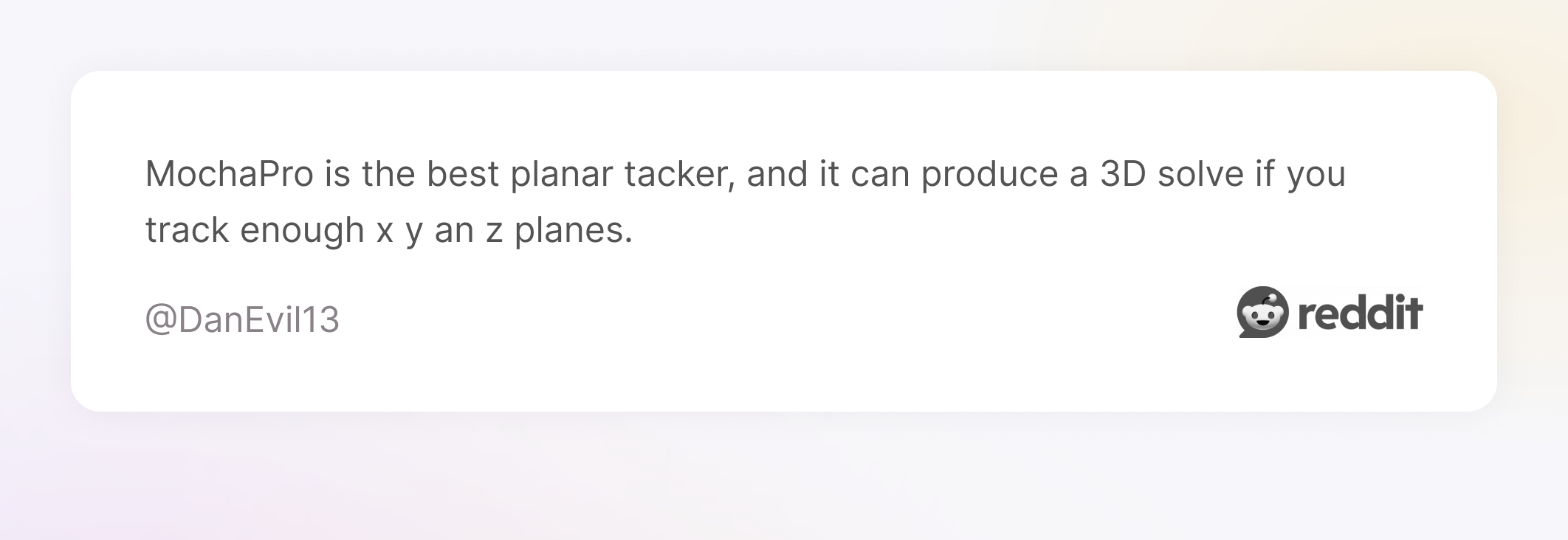
If you’ve ever looked up how much illustrations cost or the cost to hire a graphic designer, you know budgets vary widely, and motion designers often handle both illustration and animation, making them a one-stop shop for many clients.
Tool stack: Figma + Rive + ProtoPie
Design static screens in Figma, then bring them to life in Rive. ProtoPie comes in for prototyping complex logic or app flows. As one Redditor wrote, “…it would shift to ProtoPie or another tool where I can properly communicate micro-interactions, real form inputs, and “real” functionality”.
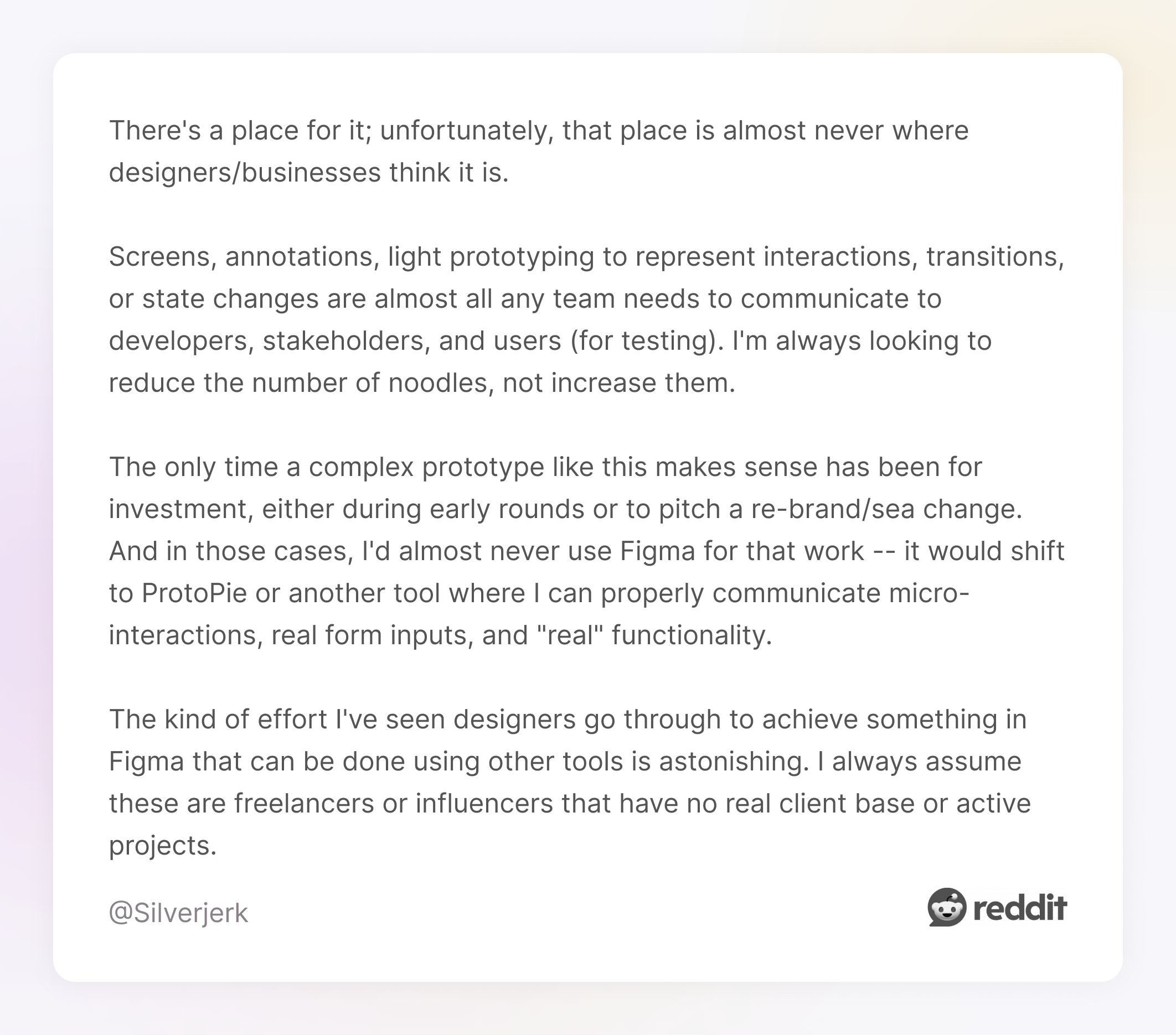
This setup is popular among SaaS designers, marketing teams, and website design agencies that require quick turnarounds.
In many ways, choosing between this kind of specialist and a broader creative partner can feel like deciding between a freelance graphic designer vs agency: the freelancer may move faster and adapt to niche needs, while an agency can integrate motion into a larger marketing or branding strategy.
UI motion often overlaps with what a marketing designer does: building animations for email marketing designs, landing pages, and interactive campaigns. These short, purposeful animations can be created in-house or via graphic design outsourcing when speed is essential.
(Alternative setup: AE + Lottie + Figma for teams that already use AE and need a dev-friendly export.)
Tool stack: Blender + After Effects + Fusion
Creates 3D visuals and scenes in Blender, exports passes, and finishes the look in AE or Fusion. Great for product reveal videos, video editors, cinematic intros, or high-end brand motion.
This is the realm where typography trends meet dynamic motion and product storytelling, often used for global campaigns, trade shows, and brand launches. Many studios blend 3D motion with static graphic design examples to create multi-channel marketing packages.
Sworiby on Reddit wrote, “AE+ Blender. Design in Illustrator (for AE) and Affinity (for Blender). Ready to ditch After Effects if something better comes along. That is not unreal.”
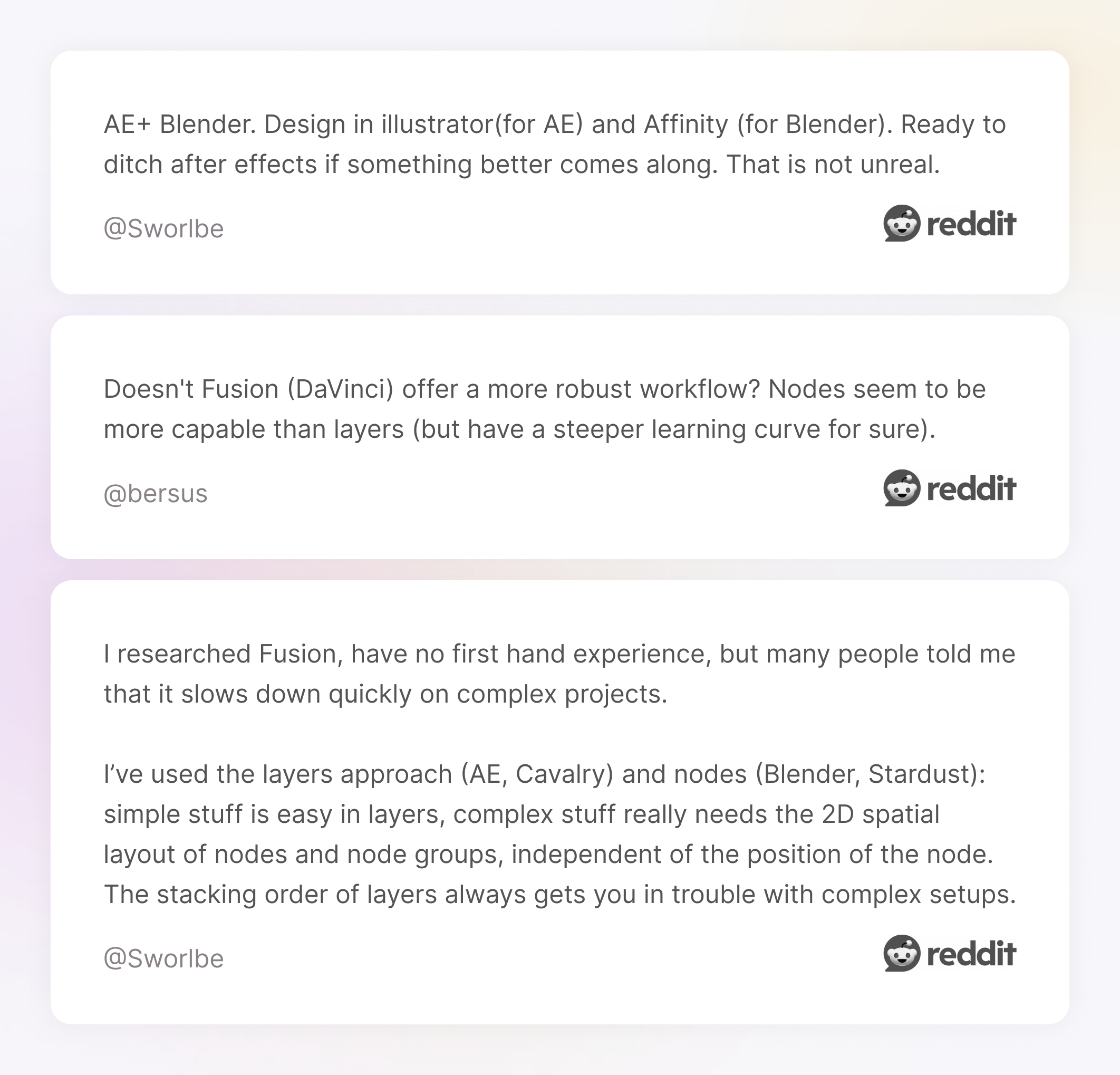
Here’s a quick visual to keep it clear:
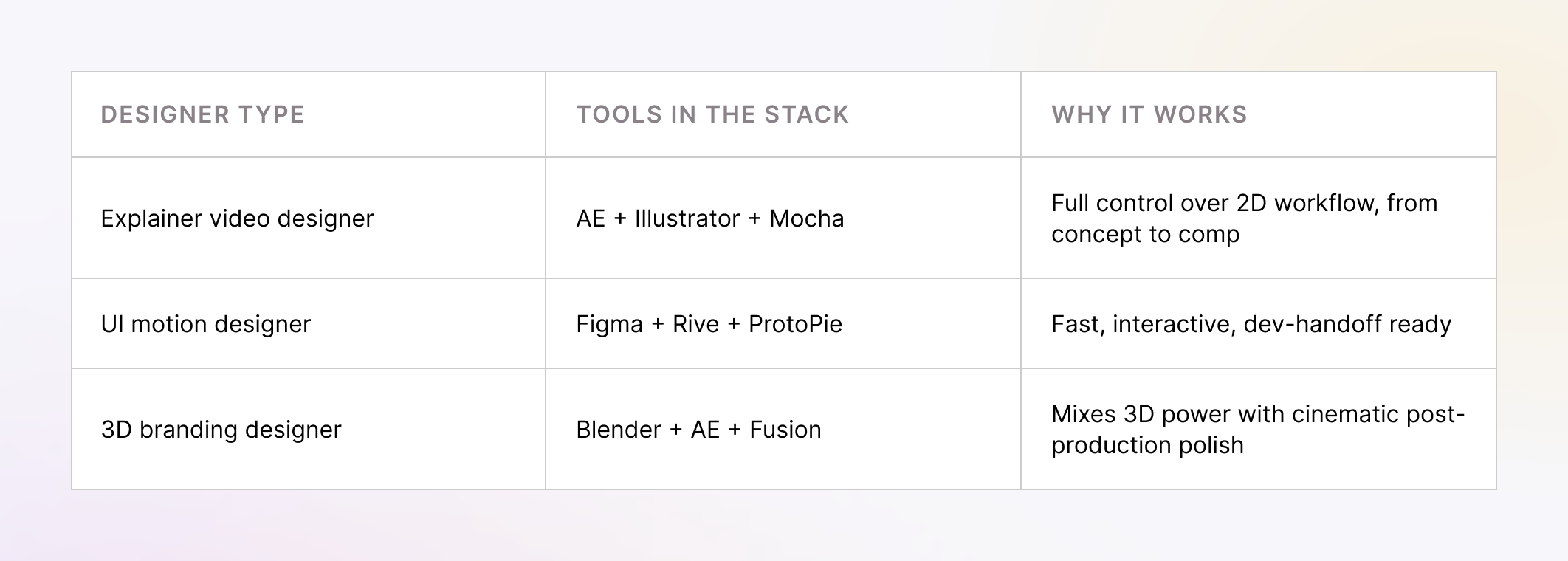
Stacks aren’t static. They evolve with projects, clients, and deadlines. But recognizing how different types of designers combine free business tools and paid ones can help you decide what’s worth learning and what you can skip.
Next, let’s hear directly from the community. What are designers saying outside of polished blog posts?
If you’ve ever lurked r/MotionDesign or r/MotionGraphics, you know: Reddit doesn’t hold back. Designers there speak their minds, especially when it comes to tools.
We pulled together some of the most honest, useful, and unexpected takes from recent threads.
Every tool has fans and flaws. Here’s what motion designers think about the ones they use most:
Reddit’s relationship with AE is pure love–hate. This user explains, “People shit on AE but there’s no competitor that can do everything AE does as well as it does.”
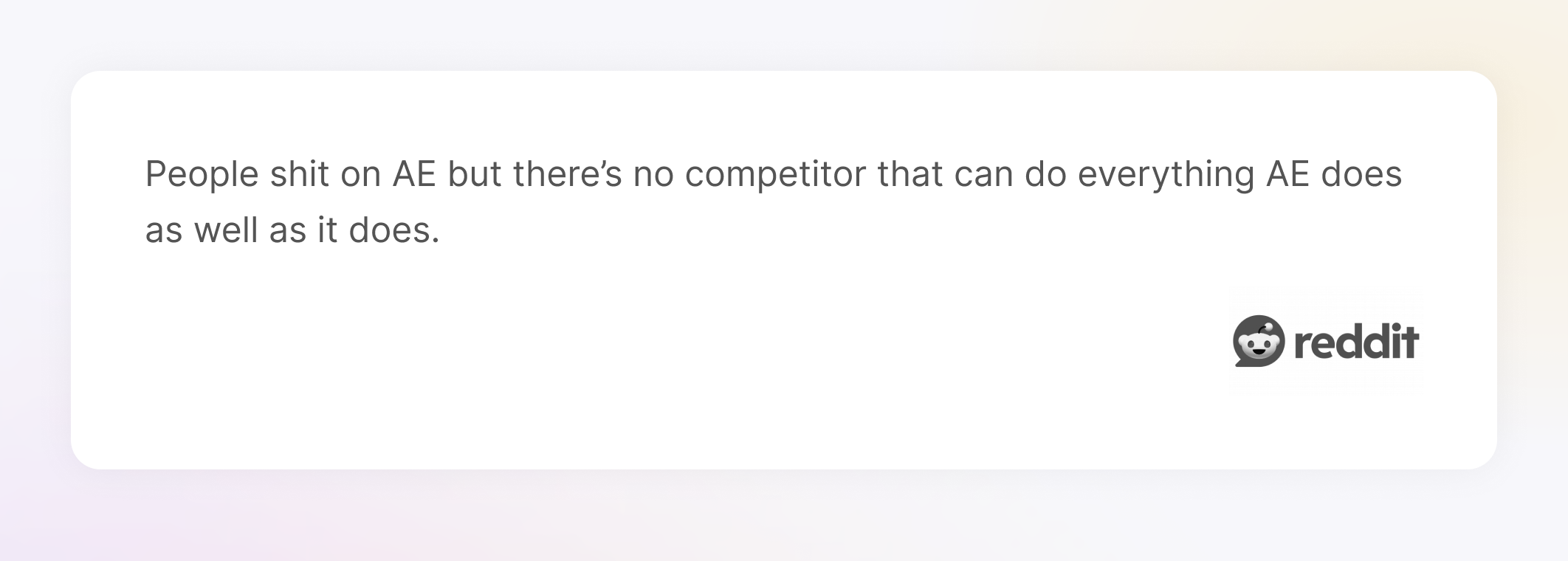
Another Redditor adds, “Efficient or not, you need to factor in whether you want to work solo or with a team. AE + Premiere Pro + C4D are widely used, so if you want to work with a studio or agency, you will need to work in the program they use.”
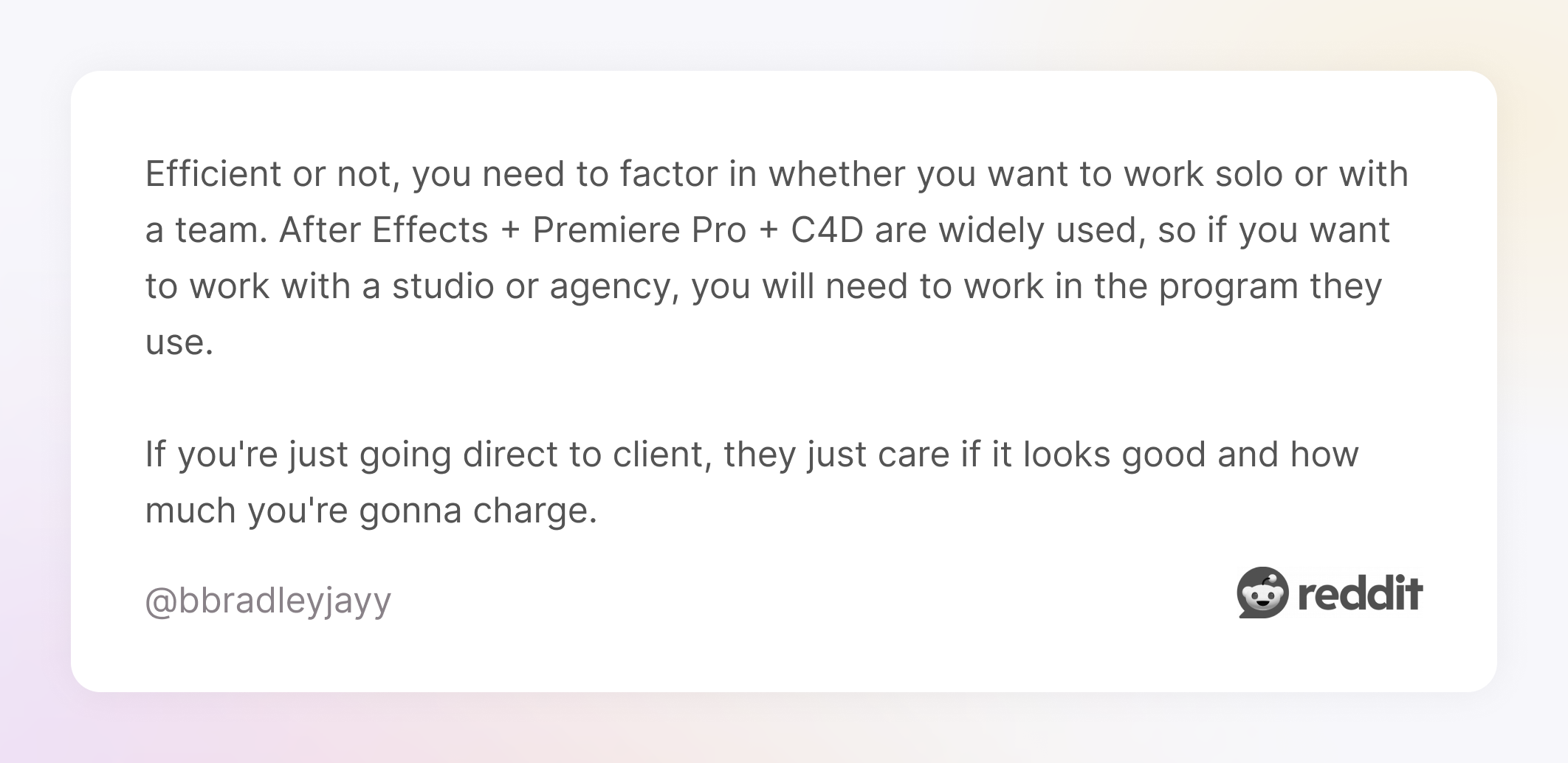
Designers praise it for power and price, but it is not yet the industry default. u/Mars-Venus-Planet wrote, “These are definitely the cheapest options, but definitely not industry standard. AE + C4D is much more common for motion design… it all comes down to your clients, workflow, projects, and personal preference at the end of the day!”
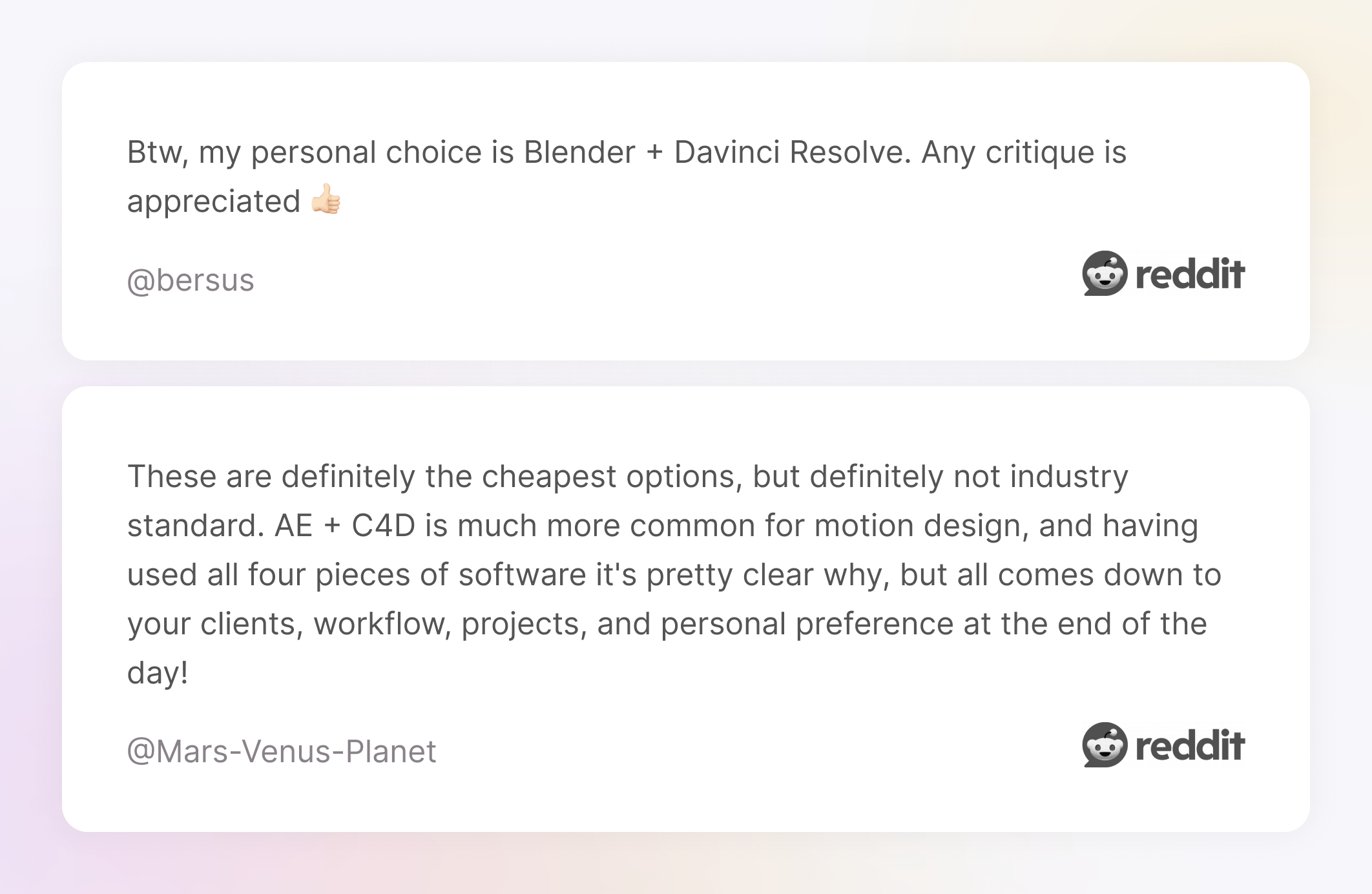
It is worth exploring and is highly loved among UI animators. One Redditor admitted, “I think it’s worth your time. After Effects is a complete dinosaur that’s ripe for the picking (off). We’re personally hitting issues with responsive design needs that AE can’t even begin to address. Makes the hungry team at Rive look VERY interesting.”
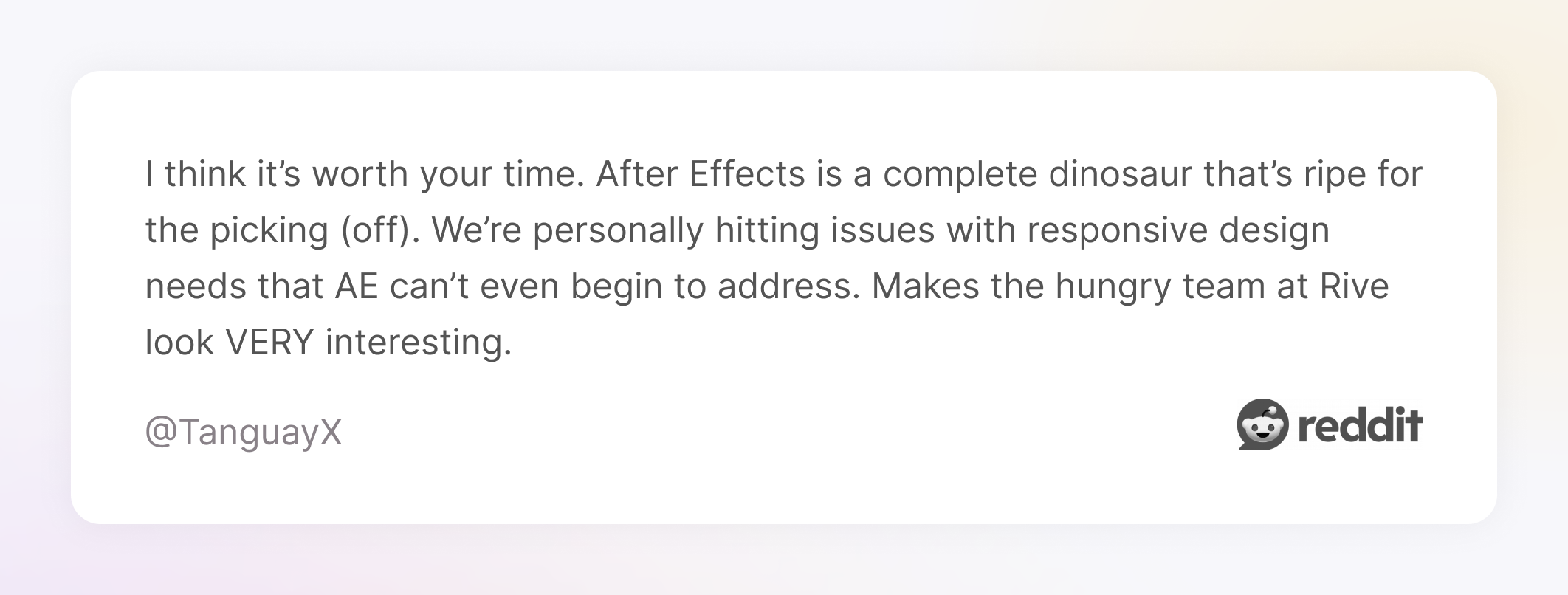
Some of the most upvoted advice is surprisingly blunt and useful:
“Moho for character animation, Fusion for more complex stuff, including 2D and 3D components (usually including Blender for the modelling part), also Apple Motion as a swiss army knife for many small tasks. Shutter Encoder for various encoding and conversion tasks. Some paper for planning ;)”
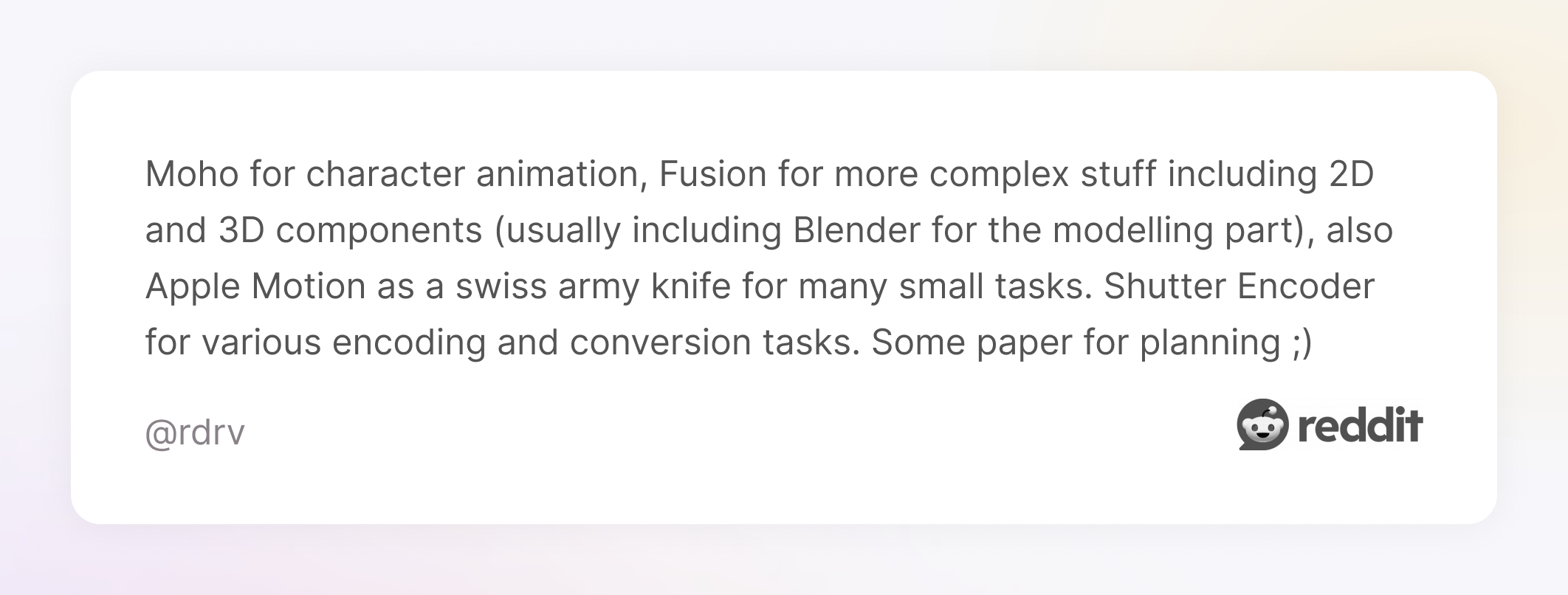
Reddit’s motion design community always has a few surprise favorites. Here are the hidden gems they love.
24. Embergen
Redditors consider this tool helpful and easy to learn, “Embergen is instantly useful. Quick to learn, you can use it to add value to your shots, but you won't get a job using Embergen. No one needs an embergen specialist, it's easy for most applications. Houdini will take you a long time to get good at, but then you'll have robust bankable skills. Valuable because those skills are non trivial to acquire.”
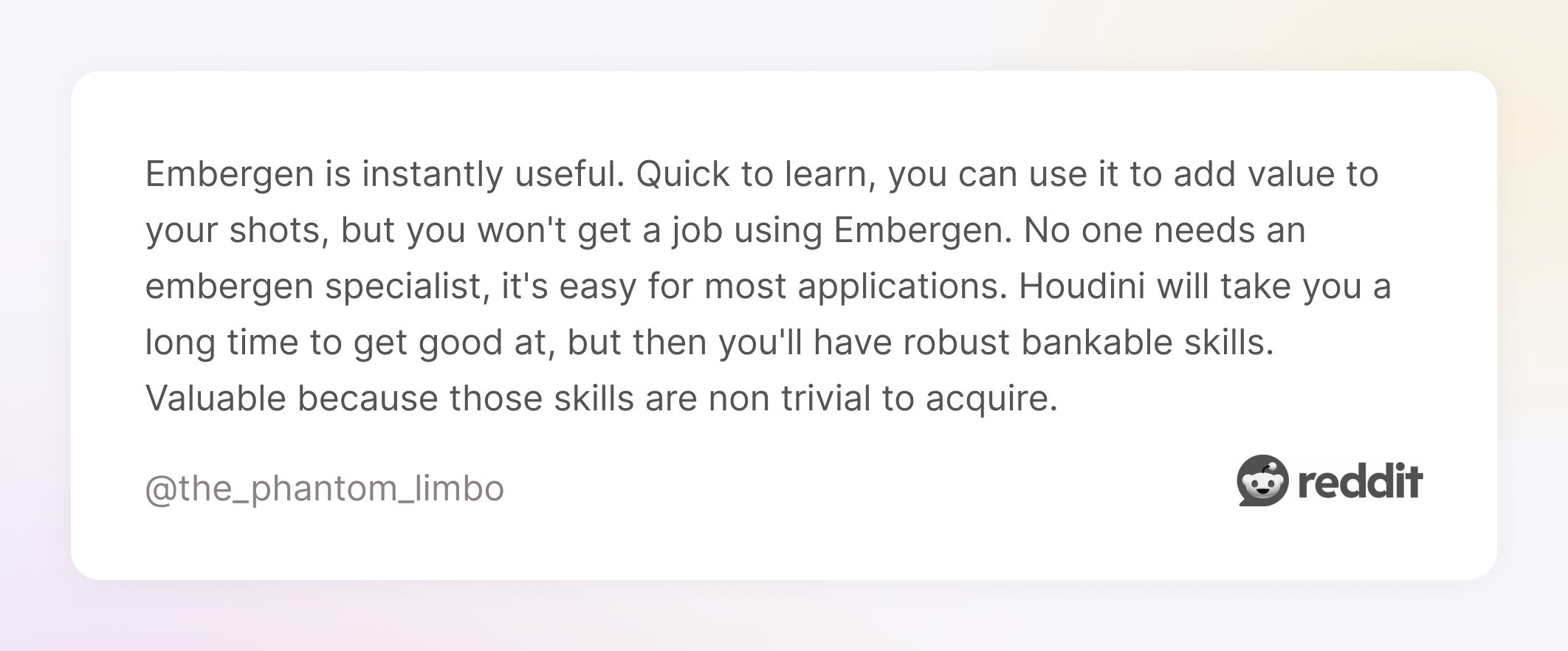
25. Houdini
One Redditor recommends to learn Houdini first, “I prefer you to learn houdini .coz the way you can manipulate the effects and redesign as per the structure or design you want.. don't go for Embergen now...learn Houdini first.”
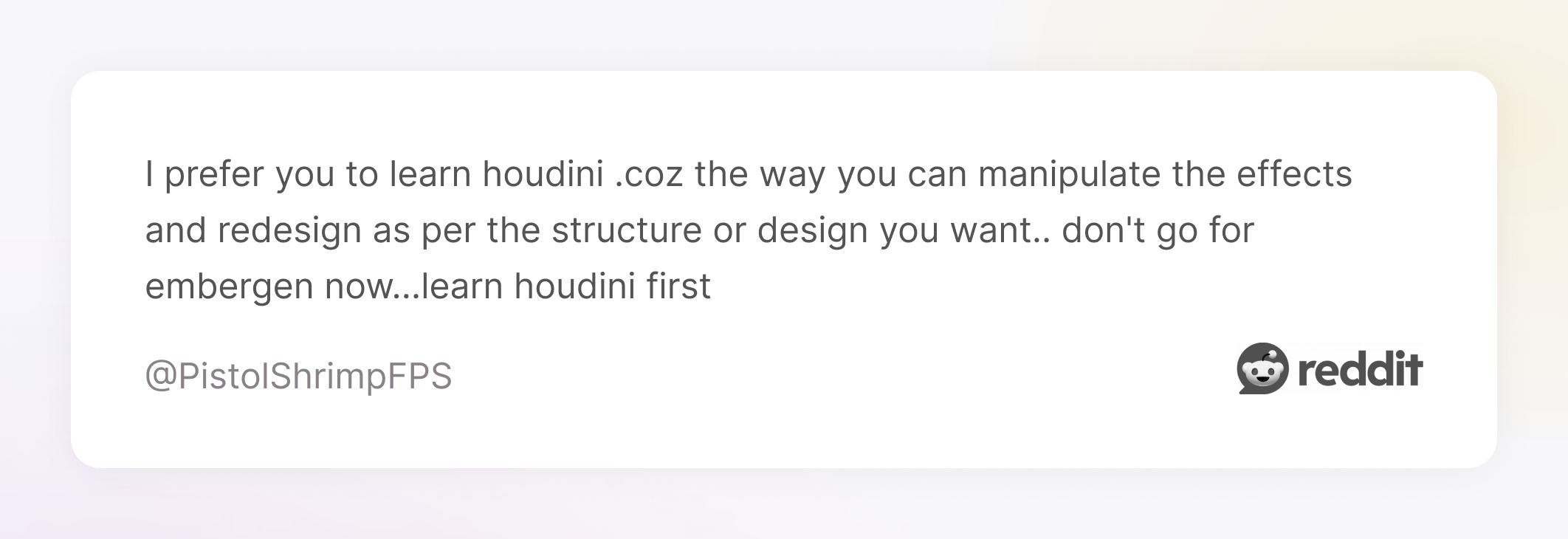
Sometimes, Redditors disagree, but these tools get mentioned repeatedly across multiple threads, by different types of designers; they are probably worth looking into, “Houdini, while Embergen is pretty good solver most of the sim look in reality is base on pre/post sim stage. Knowing Houdini will help you get good in cleaning up collision...“
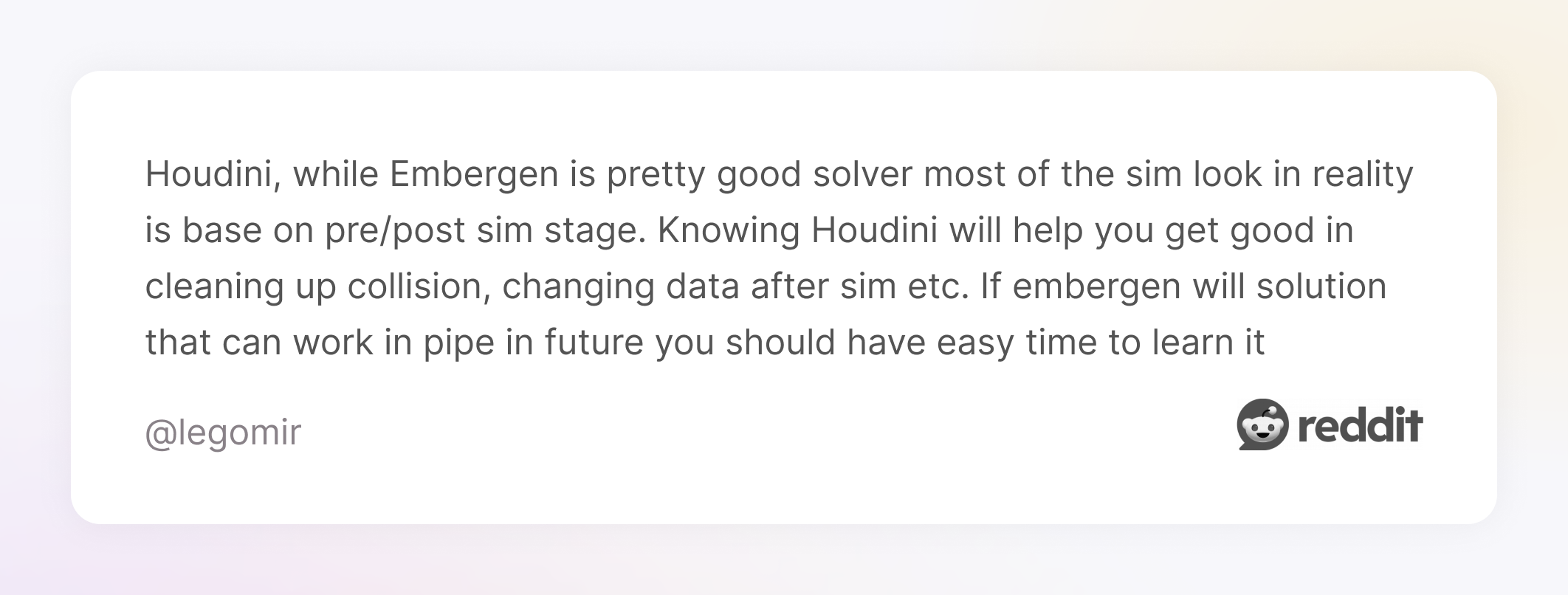
Of course, every setup comes with its challenges; here are the pain points motion designers run into most often.
We dug into the recurring issues many professionals deal with, no matter what tool they’re using:
Beginners are overwhelmed. Even seasoned users still google expressions weekly, “...That took me 4 years for AE animation alone…”
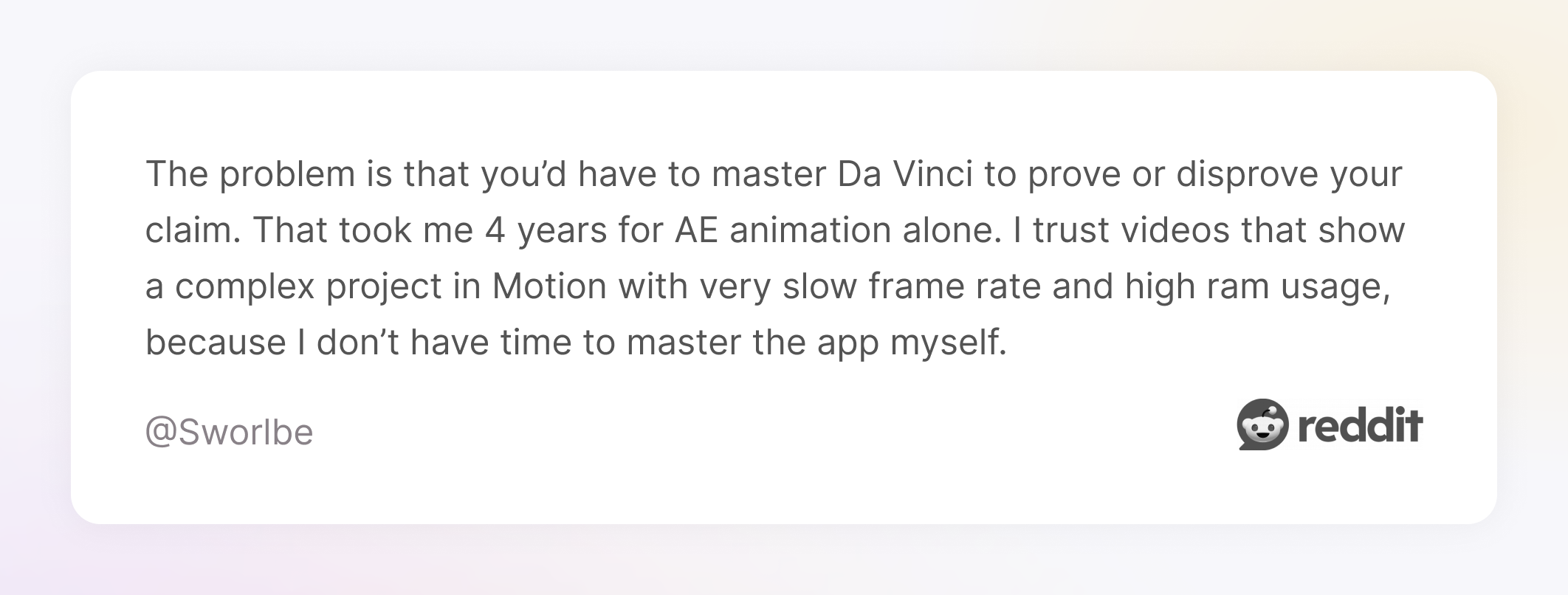
“I get it from a financial perspective I think, but I also have subscription fatigue.”
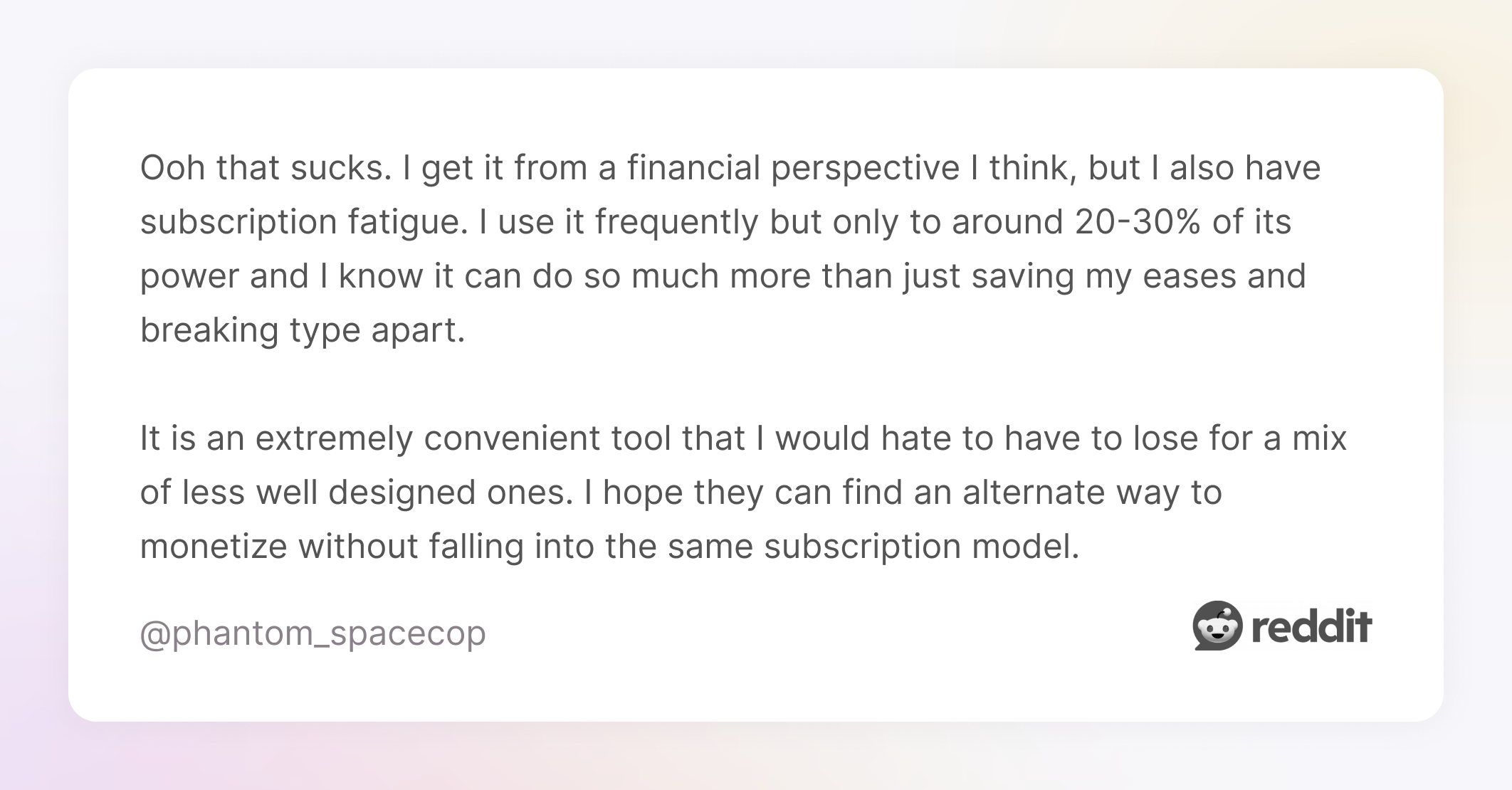
Motion designers search for new tools to translate Figma designs into web animations or find a better plugin to enhance Figma's animation capabilities. One Redditor asks, “Is that a real thing at all?...”

So what if you’re still new to all this?
Let’s build a simple roadmap for beginners, one step at a time.
This 3-phase roadmap is about learning what matters now, so you don’t burn out or blow your budget chasing shiny tools you won’t use. And if you’re building toward an MVP, you’ll want to be intentional about the cost of building it; tools can help you save or waste weeks.
Tools to start with:
If you’re just starting, focus on the basics in After Effects: learn how the timeline works, how to set keyframes, and how to use masking.
One Redditor put it, “After Effects is a good start. Obviously better if you learn Illustrator, they're my usual dynamic duo. I'm about to start learning Rive as it's faster, lighter and friendlier for exporting and editing files than AE, so maybe you wanna check that out too.”
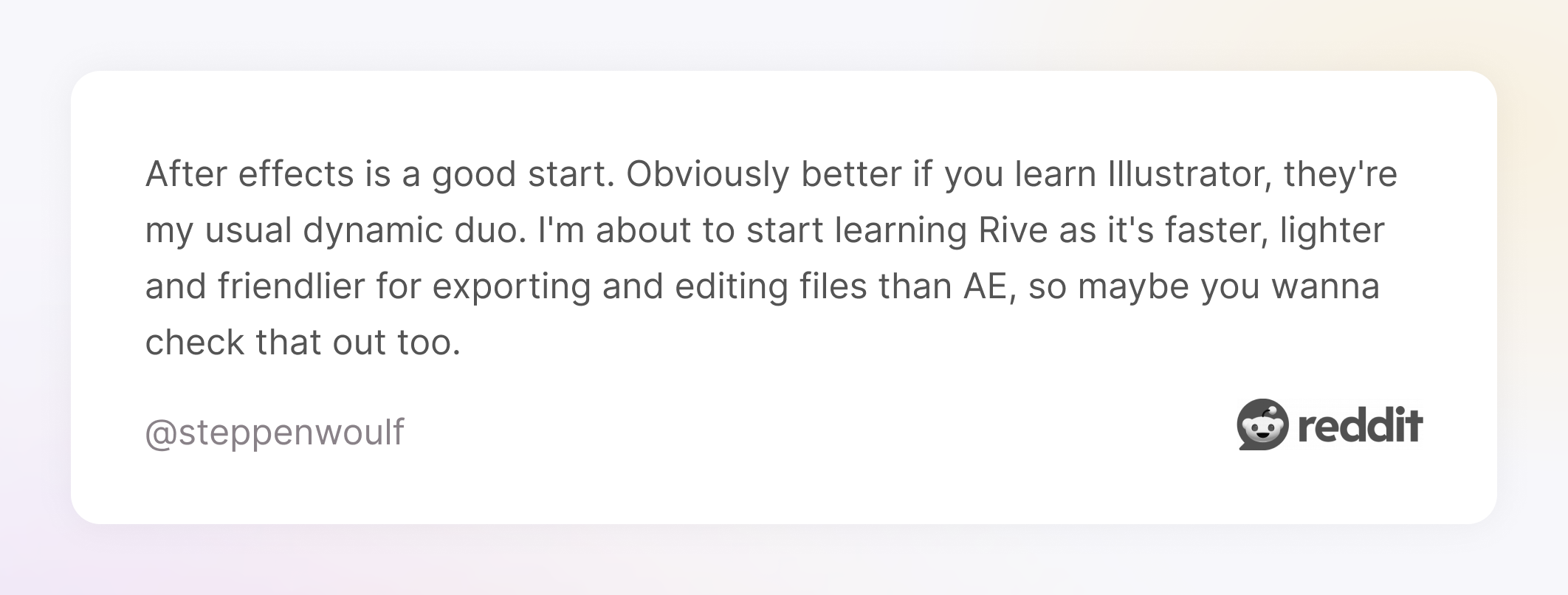
Try recreating simple motion pieces you see online to get the feel for it. Once you’re comfortable, play around with quick tools like Jitter or Lottie Lab to make small animations for social media or personal projects.
Remember: it doesn’t have to be perfect; getting something finished and shared is how you grow.
Tools to explore:
Try starting small: animate a simple button hover or toggle state. Then, explore tools like Rive or ProtoPie to create a smooth screen transition.
If you’re working from a Figma design, connect your animation back to it so you can hand it off just like the pros do.
Tip: Put yourself in a developer’s shoes. Think about how this animation would work in a real product.
Tools to try:
You can build a simple 3D scene or camera move in Blender, nothing too complex, just enough to get comfortable with the basics. Experiment with Spline to place your 3D work directly on the web. If you’re feeling curious, try a parametric animation in Cavalry, like animating multiple elements using data.
Tip: Tutorials are a guide, not a crutch. Once you understand the basics, bend the rules and make something your own.
Here are some resources to speed up your learning (free or budget-friendly):
Now that we’ve mapped a path for getting started, let’s wrap this up and remind ourselves of the bigger picture: tools are powerful, but they don’t replace craft.
It’s easy to get caught up chasing the latest tool, the smoothest UI, the fastest render. But none of these tools matter if the work itself isn’t thoughtful, clear, and purposeful.
Tools should serve the craft, not define it.
So yes, learn After Effects. Play with Rive. Try Blender, even if it scares you. But spend more time thinking about timing, easing, clarity, and rhythm. That’s what makes great motion, not buttons and plugins.
Don’t obsess over which tool is “the best.” Obsess over what you’re trying to say and then pick the tool that helps you say it better.
And if you're building something and need help? That’s what we do.
Explore our motion design services, from product animations to brand motion systems; we help teams bring ideas to life.


